
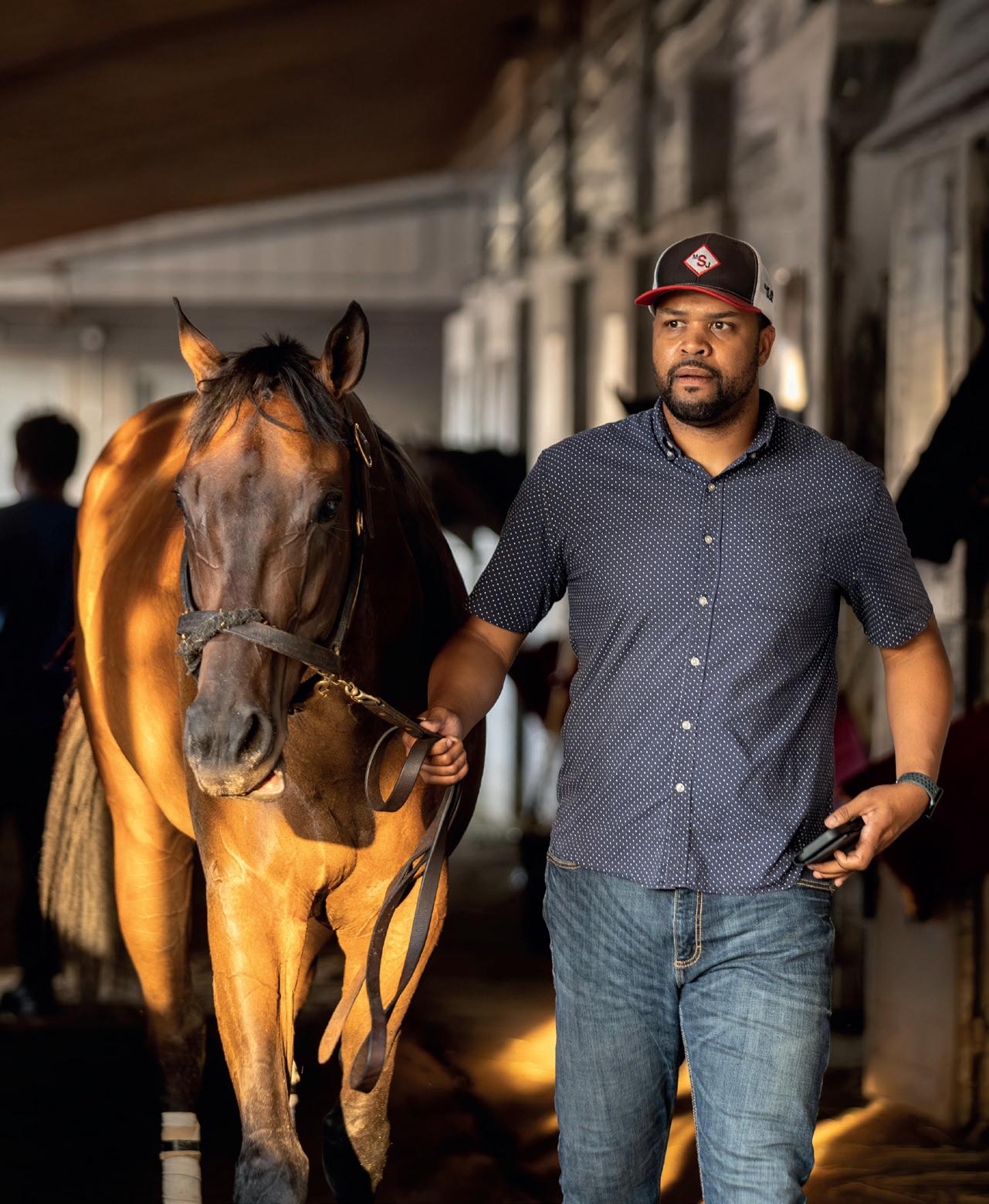
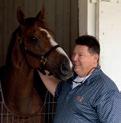
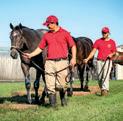


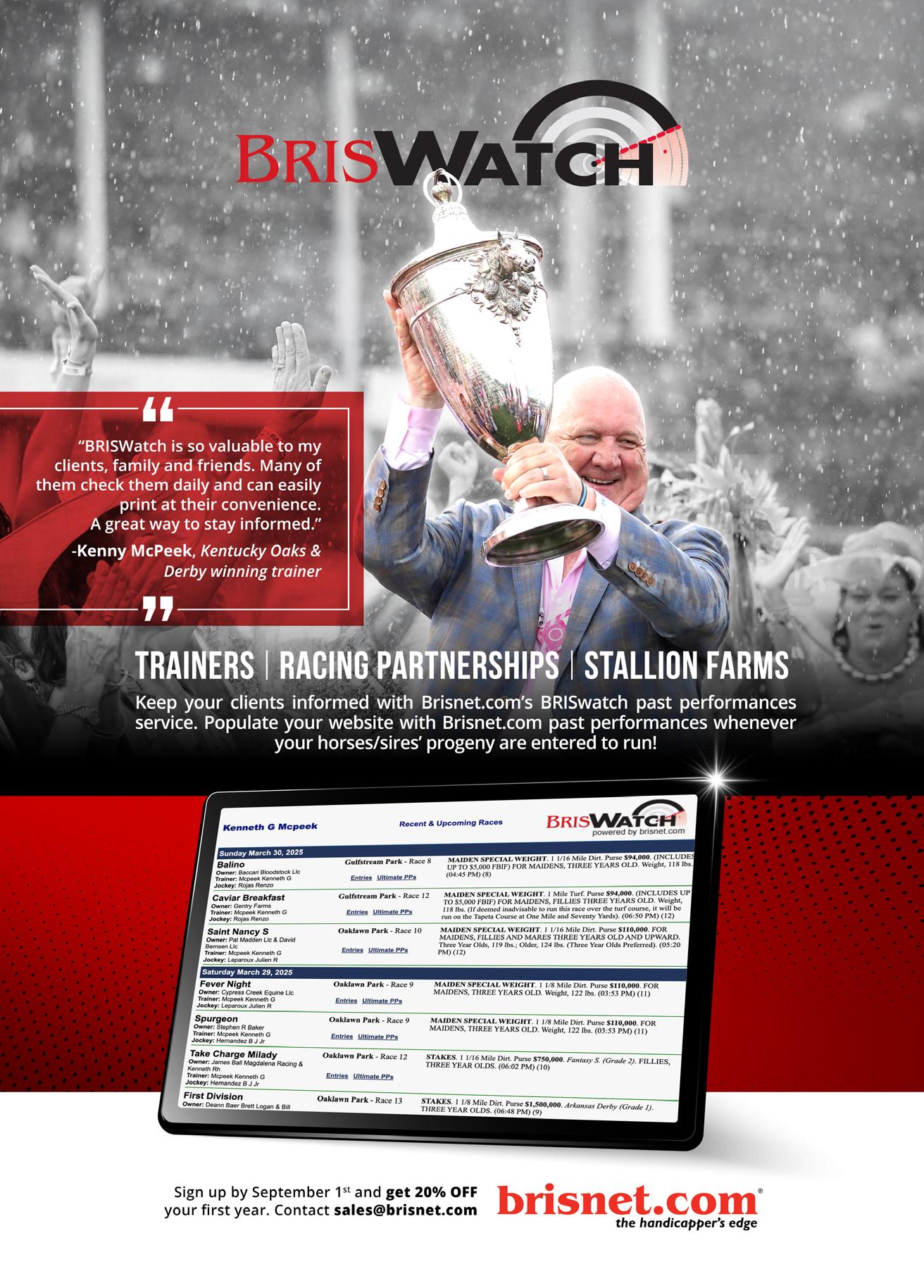










My brief to our writing team for this issue, was to come up with a shortlist of trainers that we could profile who have the respect of their peers - but aren’t yet ‘Saturday’ names.
A list of trainers duly arrived and two names stood out –Mark Simms, Jr. and Chris Hartman.
So, I thought well let’s profile both in this issue.
As we discover, Simms’ route to joining the training ranks wasn’t exactly a conventional one. He knew from a young age that he wanted to emulate his grandfather, training racehorses
Coming from a military family, he joined the Reserve Officers’ Training Corps during his time at Virginia State University, where he studied Criminal Justice and Animal Science – quite a degree combination, but both would serve him well.
On graduation, he was in an elite group of the top 2% of cadets, so got to choose which branch of the Army would suit him best. He ended up being based in Korea and then had a tour of Afghanistan.
Then after his time in the Army came to an end he joined the barn of Dale Romans who tells us that Simms has “got the work ethic of a military man. The horse stuff isn’t brain surgery and a smart guy like Mark can learn all of that pretty quick. It’s all the stuff around it that can be difficult, but he seems to have a good knack for that. A lot of people show up thinking they love horses when what they really like is horse racing, and those can be two different things. And Mark obviously has a love for the horse. It really seems like it has enriched his life.”
Hartman on the other hand, took a pass on high school but got his first racetrack paycheck at the age of eleven. From that point, there was to be no stopping him on his road to becoming a trainer.
At the age of fourteen, he purchased his first horse, Jat Alane, from trainer Michael Freeman at Turf Paradise for just $300. Two years later, Hartman was running the shedrow for Freeman.
A year later another horse was purchased for just $500 who won second time out on December 28, 1990 and as Hartman tells us, “he paid one-hundred eighty-nine dollars. I was training horses but I wasn’t old enough to have a license, so the horses were in my dad’s name.”
Fast forward to summer 2025 and Hartman finished the recently concluded Churchill Downs spring meet as the 4th leading trainer.
The journeys which both Simms and Hartman have taken to get to where they are today are completely different. Both have the will and determination to succeed and I’m sure that in the coming years they will both be handling ‘Saturday horses’.
Wherever your racing takes you this summer - good luck!

Editorial Director/Publisher & Advertising Sales
Giles Anderson (859) 242-5025
Sub-Editors
Lauren Godfray & Nico Jeeves
Advert Production, Circulation/Website
Lauren Godfray (1 888-218-4430)
Cover Photograph
Bee Buck Photography
Trainer Magazine is published by Anderson & Co Publishing Ltd.
Tel: 1 888-218-4430 Fax: 1 888-218-4206 info@trainermagazine.com www.trainermagazine.com
North America
PO Box 13248, Lexington, KY 40583-3248
United Kingdom
Ground Floor Office, 72 Medstead Road, Beech, Hampshire, GU34 4AE

Trainer Magazine is the official magazine of the California Thoroughbred Trainers. It is distributed to all ‘Trainer’ members of the Thoroughbred Horsemen’s Association and all members of the Consignors and Commercial Breeders Association, the Maryland Horse Breeders Association, the Pennsylvania Horse Breeders Association, the Alberta Thoroughbred Owners & Breeders Association and the Virginia Thoroughbred Association.
Alan F. Balch was hired as the executive director of the California Thoroughbred Trainers in April 2010. His professional career in racing began at Santa Anita in 1971, where he advanced to the position of senior vice president of marketing and assistant general manager, and was in charge of the Olympic Games Equestrian Events in Los Angeles in 1984. He retired in the early 90s to become volunteer president of the National Equestrian Federation of the USA, as well as of the National Horse Show of Madison Square Garden.
Jackie Bellamy-Zions has been Equine Guelph’s communications manager for the past ten years. Jackie has over 30 years of experience in the horse industry in the capacity of coach, trainer, stable manager, competitor, judge and journalist.
Michael Compton is an Ocala, Florida-based freelance writer. He previously held leadership roles as editor-in-chief of The Florida Horse magazine and managing editor of California Thoroughbred. He contributes coverage of the 2-year-olds in training sales to Bloodhorse magazine and works with PM Advertising.
Bill Heller is an Eclipse Award-winning author who published his 27th book, Fred Hooper – The Extraordinary Life of a Thoroughbred Legend. His other biographies include Hall of Fame jockeys Ron Turcotte, Randy Romero and José Santos. Bill and his wife Marianne live near Gulfstream Park.
Alicia Hughes is an award-winning writer and reporter with more than 20 years of experience. She currently serves as Director of Communications for Ocala Breeders’ Sales Company and previously served as Racing Editor for The Blood-Horse and lead turf writer for the Lexington Herald-Leader newspaper from 2008-2016.
Jennifer S. Kelly is an author and freelance turf writer. Her first two books, Sir Barton and the Making of the Triple Crown and The Foxes of Belair: Gallant Fox, Omaha, and the Quest for the Triple Crown, chronicle the lives and careers of the first three American Triple Crown winners. She also contributes to The Racing Biz, America’s Best Racing, and TwinSpires Edge
Jessica Licausi, is currently a junior at the University of Kentucky, and a Keeneland College Ambassador for the class of 2025-26. Jessica also works at Spendthrift Farm, looking after mares and foals, and prepares yearlings in the summers. She has an extreme passion for the Thoroughbred industry, and feels honored to be surrounded by so many amazing people who have believed in her since the very start of her journey.
Professor Celia Marr is an RCVS recognized Specialist in Equine Internal Medicine based Rossdales Equine Hospital and Diagnostic Centre, Newmarket, England. She has previously worked at Cambridge University, the Royal Veterinary College, the University of Pennsylvania, and in racehorse practice in Lambourn, England and is editor of Equine Veterinary Journal
Catherine Rudenko is an independent registered nutritionist with a focus on Thoroughbreds. Based in the UK, she has worked across the USA, Europe, and Asia, creating customized feeding plans for trainers and studs. Passionate about education and research, she collaborates with professional bodies and universities to promote equine nutrition.
Ken Snyder is a current turf writer for Gallop Magazine, and a turf/travel-culture writer for Kentucky Monthly magazine. His work has appeared, as well, in other publications, including The Blood-Horse He and his wife, Cassie, reside in Kuttawa, Kentucky.
Laura Steley BSc Hons in Equine Sports Science, is the senior stud secretary at Shadwell Stud in Newmarket, England and a regular contributor for Owner Breeder magazine. She brings experience in Thoroughbred pre-training, rehabilitation, and as an international racing data analyst.








Trainer Magazine (ISSN 17580293) is published 4 times a year: February, April, July and October by Anderson & Co Publishing and distributed in the USA by Modern Litho | Brown Printing, 6009 Stertzer Road, Jefferson City, MO 65101. Periodicals postage paid at Jefferson City, MO, and additional mailing offices.
POSTMASTER:
Send address changes to Trainer Magazine, Anderson & Co Publishing, PO Box 13248, Lexington, KY 40583-3248.








08 Where purpose meets passion
Alicia Hughes profiles retired US Army Officer, Mark Simms, Jr. who swapped the discipline of the battlefield to the demands of the backstretch to train Thoroughbreds.
16 Still learning, still winning
Ken Snyder profiles trainer Chris Hartman, who took a pass on high school, got promoted to groom before he knew how to muck a stall and blew right past the assistant trainer’s position straight to trainer.
22
Jennifer Kelly reports on the resurgence of racing and breeding in New York and what other states can learn from the Empire State.
32 Organic minerals
Catherine Rudenko looks at how and why the nutrition industry is changing the delivery of minerals to horses from inorganic to organic formats.
38 Prepping yearlings
Jessica Licausi talks to consignors about how getting yearlings ready for sale has changed over the last twenty five years.
44 Market boom!


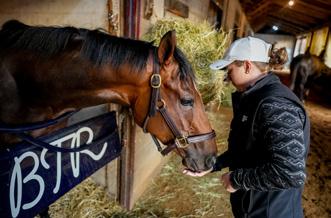
Michael Compton discusses how despite economic uncertainty, the 2yo sales of 2025 still produced a set of impressive results.
Bill Heller features Pin Oak Stud with Parchment Party, Lael Stables with She Feels Pretty and Gabriel “Spider” and Aisling Duignan with Echo Sound.
60
Celia Marr gives tangible improvements to equine safety and welfare to reduce the prevalence of both EASD incidents and severe musculoskeletal conditions.
Laura Steley reports from the 2025 Gerald Leigh Memorial Lectures where we learn about the latest research in laryngeal surgeries and tendon rehabilitation.
72 A look at ‘Learning Theory’
Jackie Zions interviews Sally King and Dr. Katrina Merkies on how learning theory can reduce stress and aid the development of top performers.
06 View from the CTT Alan Balch – Future?
78
#Soundbites
Bill Heller asks “How much do the opinions of others affect your yearling evaluations?”


Pre-Entry Opens Online October 1
Breeders’ Cup World Championships
14 Grade I Championship Races • Over $34 Million in Purses and Awards
It’s time to take your place among the world’s greats. Pre-entry for the 2025 Breeders’ Cup World Championships opens online October 1 and closes at Noon (PDT), on Monday, October 20. All Breeders’ Cup World Championships races are non-invitational and are open to all thoroughbreds competing around the globe.
Offering purses and awards over $34 million and each race pays through the 10th finish position! Each Breeders’ Cup World Championships starter receives a travel award up to $10,000 for domestic horses and $40,000 for international horses shipping into California.
Enjoy exclusive world-class hospitality on racing’s biggest stage, including premium reserved seating for you and your guests, participant hotel accommodations including a credit for your stay, access to hospitality lounges, executive car service, and invitations to exclusive events.
To pre-enter online beginning October 1 and access the digital Horsemen’s Information Guide, visit members.breederscup.com. members.breederscup.com | 859-514-9422 | racing@breederscup.com

According to etymologists, the word “future” only dates to the 1300s.
Human life up to then, I guess, must have been so “solitary, poor, nasty, brutish, and short” (to copy the philosopher Thomas Hobbes’ description of life outside society), that humanity could scarcely conceive of the very idea of a “future.”
If we could envision the concept of a future, I reason, we would have had a word for it.
This surprises me, since like so many other things it invented, horse racing may itself have started the first intense debates about what “the future” holds: according to the latest Artificial Intelligence, there was gaming on the races as far back as ancient Egypt, Greece, and Rome. Way, way before the 14th century.
You have to understand the concept of “future” if you’re betting on an outcome that hasn’t yet occurred. Our entire sport, one might say, is “future-oriented.” If we knew with certainty what a result would be, we would have no game. And far, far less fun.
Just ask everyone who went against the bridge jumpers who bet the ranch on that 1-9 shot to show … which then didn’t. Or, ask the breeders. They “breed the best to the best and hope for the best,” the aphorism often attributed to John E. Madden. Yes, that family … of Hamburg Place in Kentucky.
So, “future-orientation” is the foundation of horse racing in many respects, beginning with breeding. It’s also something I deeply considered in my last school days, and again in my early days of race track marketing at Santa Anita, more than half a century ago.
One of my teachers, Edward Banfield, wrote a controversial book, The Unheavenly City, in which he
argued that social class distinctions in human society are not determined by heritable biological traits such as race, or similarities among income, occupations, schooling, or status. Those had been almost universally understood to cause classes among people, and it’s probably still a consensus. Instead, he held, a person’s class is determined by a “psychological orientation toward the future,” that is to say, whether a person is more or less oriented toward the future or the present. The more future-oriented, in his view, the “higher class.”
Gamblers, I found out through research, tend to be “present-oriented.” Tend to live “moment to moment.” And I saw this constantly throughout the race track, whether in the exclusive areas with dress codes for the ultra-wealthy, or on the grandstand main floor at the wire, where the blue-collar crowd congregated. Occupation, race, appearance, and income varied absurdly – the presentoriented bettors want action, now! Immediate gratification.
Banfield believed instead that a person’s relation to time gave them their “class culture,” which in turn then influenced their tastes and behavior.
Thoroughbred breeders are required by laws of nature to be future-oriented (mares requiring almost a year for gestation, added to the time necessary for planning matings); yet breeding is also, by definition, high-risk. Risk abounds everywhere else in racing, too. Isn’t this among the seductive allures and fascinations and contradictions racing provides, like no other sport?
In my track-management decades, the public companies I worked for always confronted the tension between earningsper-share-this-quarter vs. investing for future growth. We couldn’t escape
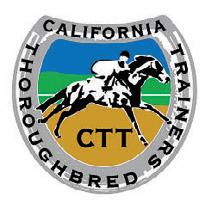
public disclosure of our audited financials, whether for shareholders or regulators. The discipline this required of California track management, unfortunately, seems to be a thing of the past, over more than the last two decades.
And the result looks increasingly catastrophic.
Every decision that any track management makes has to account for the size of the horse population available to race. This should go without saying – but in California, it doesn’t! Management can announce the end of racing at a track which undergirds most of a state’s breeding, apparently without understanding or considering the consequences, not only for every other connected enterprise in the state, but also for itself. And without any objective evidence of the basis for its financial decision-making.
And, if it did understand or consider those consequences of its decisions, ponder the implications of having made them anyway.
In the 2025 Santa Anita meet which ended in June, California-breds accounted for just under half of all starts, an all-time high. As of May this year, not coincidentally, horses bred in California were over 51% of the total population stabled in the south, including 60% of the population at Los Alamitos. Every one of those was bred while year-around racing was conducted at Golden Gate Fields and the fairs in Northern California – where over 70% of starters were bred in the state.
As the North American foal crop has steadily declined, according to The Jockey Club Fact Book, the Kentucky share has been rising, to nearly 50% now. The California, Florida, and other shares, for the most part, have been declining precipitously. The implications of this are ominous for the geography of American racing as it has existed for nearly a century.
What the future holds will always be as mysterious as peering out into the vast universe with stark wonder. And all of us in racing know better than the rest of the world, and every investor, that “past performance is not indicative of future results.”
In our own California case, however, past performance has brought us to an exceptionally precarious position.








here is a level of ease that radiates off individuals fortunate enough to exist entirely within their element, an enviable calm that never waivers even when honing their craft in an industry designed to be a 365/24/7 grind.
Theirs is the kind of vibe that hangs like pollen in thick summer air and drapes itself all over those who enter their orbit, which explains why the far end of Barn E at Churchill Downs’ Trackside Training Center in Louisville is as much a sanctuary for its occupants as it is a hub for aspirations. Through every pass down the shedrow, every forelock that gets rubbed, every conversation had with a visitor, friend, or colleague, it becomes as obvious as the black and red sign with the white diamond out front.
Mark Simms, Jr. is exactly where he should be – the byproduct of having spent the brunt of his adult life forging a path toward what he believed was his inherent destination.

“For sure, this is definitely my passion,” the 36-year-old trainer said through a widening grin. “I was telling my wife the other day how relaxing it is to come to the barn. No matter what’s going on elsewhere, coming to the barn and being around the horses, it’s just super tranquil.”
Technically, there is little in the way of tranquility in the life of a Thoroughbred racehorse trainer. There is no off season, or real days off for that matter, and one’s entire livelihood hinges on the ability of 1,000-pound athletes supported by sinewy limbs as fragile as they are powerful.
Yet, from the time he took his first steps while trying to follow his grandfather to the barn to serving his country in the Army during tours of duty in Korea and Afghanistan, the demands of a life that revolves around equine athletes is what Simms sought the most. It was an ambition he chased even when the world presented him with chance after chance to settle into an illustrious career path he had already proven he could excel at.
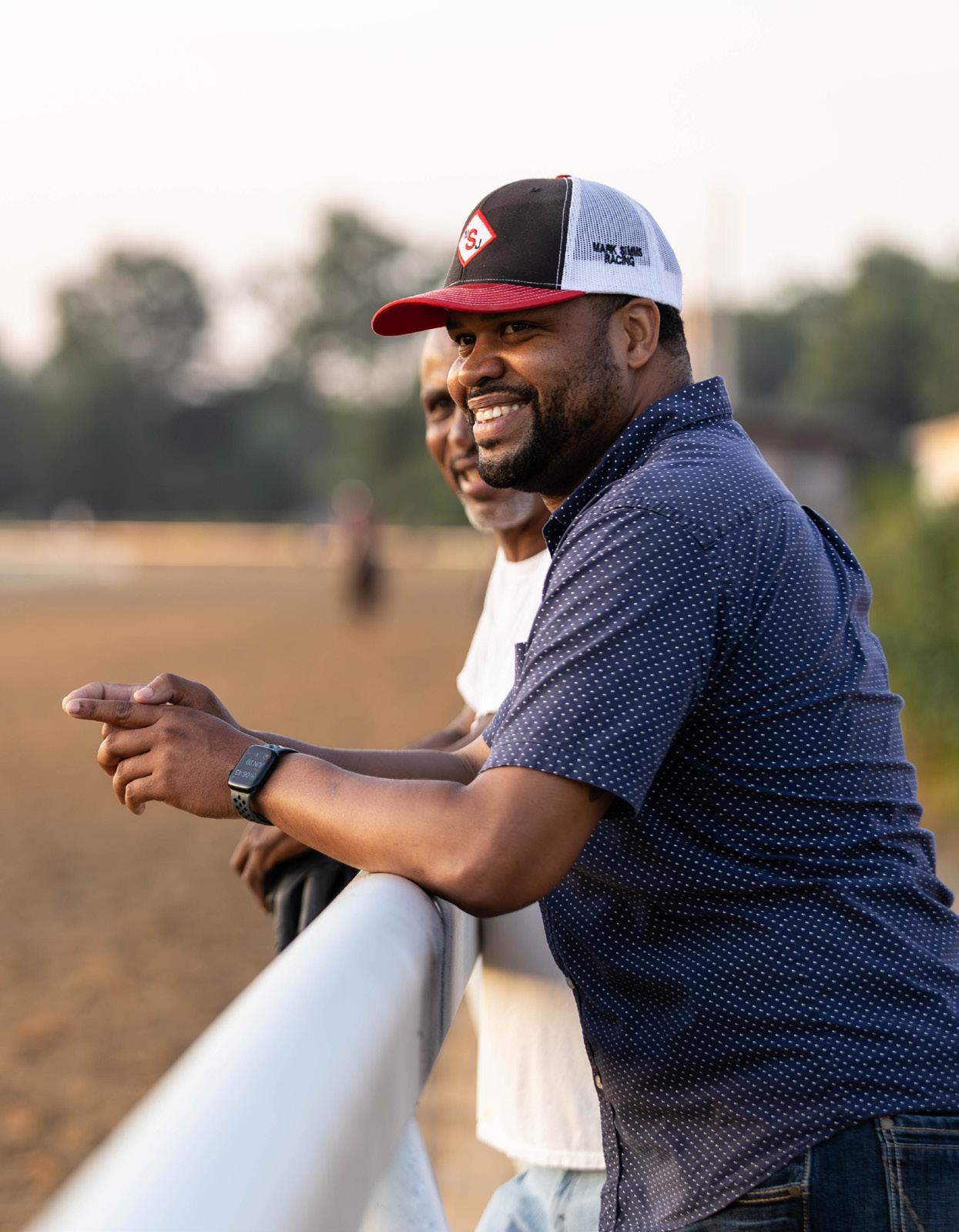
Hence, as he goes about his morning routine in the barn with his name on it filled with horses owned by some of the most storied clients in the sport, the appreciation for his most challenging and rewarding journey to date is almost tangible.
There is a plethora of metrics used to measure success amongst trainers – win percentages, stakes victories, purse money, graded triumphs. While attaining lofty marks in those categories is as much as goal for Simms as it is for any of his comrades, the fact he found a pathway into an industry that doesn’t easily open doors for those who don’t descend from a certain ilk is as much an achievement as any piece of hardware from a Grade 1 test.
While he comes from a long line of horsemen, including his grandfather who was a trainer himself, Simms’ arrival at his current reality is one even Hollywood’s most creative screenwriters would be hard pressed to conjure. Born in Texas, he grew up on the Turtle Mountain Band of Chippewa Indian Reservation in North Dakota near Chippewa Downs racetrack, the product of a military family. Even as he followed in his parent’s footsteps - being in the Reserve Officers’ Training Corps (ROTC) while enrolled in Virginia State University, becoming an Intelligence Officer and eventually rising to the rank of captain in the Army - fate always kept him close enough to horses to where he could never quell the zeal that had manifested since he took those first wobbly strides toward his grandfather’s stable.
To sign up for such a vocation requires an uncommon passion, discipline, faith, and work ethic lest one get devoured by the unyielding highs and lows that are the sport’s hallmarks. To keep chasing a dream that promised to do nothing but test those intangibles at every point of call demanded something as unique from Simms as his backstory itself.
“I always wanted to train horses; I knew that. Training horses, being around horses is really all I ever wanted to do…but I really didn’t think it was feasible there for a while,” Simms said. “Even
throughout my time in the Army, I was always trying to get close to the horses, but I just didn’t have a path to get in. Horse racing, especially in Kentucky, it’s super inbred to where people’s dads were trainers, their moms were trainers, or they were tied to a farm. Really, my way in was being in the military.”
During his freshman year at Virginia State University, as he began studying toward the degree in Criminal Justice and minor in Animal Science he would ultimately graduate with, Simms worked at a nearby horse farm in his free time to try and satiate his lifelong calling, a move most of his acquaintances dismissed as a pipedream.
He did have a certain individual in his corner, however, encouraging him not to let his passion project become just that.
“I met my wife in college our freshman year and I was working at a farm just to be close to the horses,” Simms said of his wife, Shayla who works as a Pediatric Intensive Care Unit nurse. “I would tell people ‘I want to train horses’ and everyone was like ‘You’re crazy’. But she was really the first person to really be like ‘You can do this’. That’s how I knew she was the one.
“She would buy me books about horse racing and just horses in general just to show her support. That’s when the gears started turning a bit. But I did ROTC, so I knew after college I was going to be an officer in the Army.”
As a result of being in the top 2% of cadets in the nation, Simms got to choose which branch of the Army he wanted to go into. He settled on Korea first in 2011 and while there, would find his way to the racetracks on the weekends all while keeping tabs on the major goings on with the sport back home. When the time came for him to pick a new duty station, he chose an infantry brigade in Fort Knox, Kentucky that was getting set to deploy to Afghanistan.


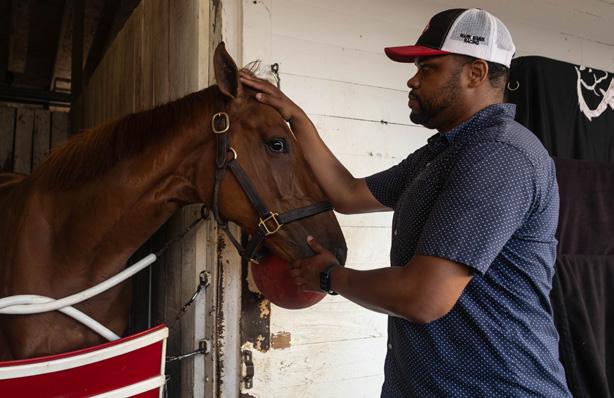

Once the papers came through saying he was officially being assigned to the Bluegrass State, putting him less than an hour’s drive from Churchill Downs, Simms leaned into the opportunity and began reaching out to trainers about the possibility of gaining the experience necessary to advance his dream while simultaneously advancing his career.
“I tell people all the time, the Army made the mistake of sending me to Fort Knox,” Simms laughed. “I got close to racehorses again.”
While Thoroughbred racing is littered with those who think they want to delve into the industry only to get a rude awakening when ensconced in the unyielding nature of the business, the discipline embedded in Simms as a result of his background caught the attention of one of the sport’s more heralded barns.
Louisville native Dale Romans, who earned the Eclipse Award in 2012 as the nation’s outstanding trainer, had a member of his staff at the time in Tari Hendrickson who herself had family in the military.
She responded to Simms’ email by telling him he was free to report to Romans’ training center in Goshen once he reported for duty.
“On the weekends and even sometimes during the week, because I didn’t have to be in the office until like 9 a.m., I would get up at 4 a.m. drive up there to Goshen, train horses in the morning, take a shower, throw on my uniform, and go to work,” Simms recalled. “And when I got back from Afghanistan (in 2014), I started thinking ‘I can do this.’”
Over the course of the next four years, Simms would establish himself as an assistant to Romans while also holding down a job at GE (General Electric), heading to the barn before work and helping to hone the likes of such proteges as Travers Stakes winner Keen Ice, fellow Gr.1 winners Brody’s Cause and Free Drop Billy, and future top sire Not This Time. Though horsemanship had long been a part of his DNA, getting to be around top-level runners and learning how to develop them into such was an invaluable piece of the puzzle Simms couldn’t get enough of.
“He’s got the work ethic of a military man. He got to see a lot of things, a lot of good horses and figure out what he needed to do,” Romans said of Simms. “The horse stuff isn’t brain surgery and a smart guy like Mark can learn all of that pretty quick.


It’s all the stuff around it that can be difficult, but he seems to have a good knack for that. A lot of people show up thinking they love horses when what they really like is horse racing, and those can be two different things. And Mark obviously has a love for the horse. It really seems like it has enriched his life.”
Days before the 2017 Preakness Stakes, Simms’s grandfather Michael Nelson – the one who told him he needed to walk on his own if he wanted to join him in the barn - passed away. Soon after, Simms decided the time had come for him to take his most definitive solo steps yet.
“When he passed, I was like, man I have to at least give it a shot,” Simms said.
Despite the fact the foundations of the sport were built on the backs of the African-American community, many of the racist ideologies that drove Black horsemen out during the Jim Crow era still resonate to this day. Where Black jockeys and trainers once reigned over the sport’s greatest prizes – with Black reinsmen winning 15 of the Kentucky Derby’s first 28 runnings and Hall of Famers like Ed Brown among the most accomplished horsemen of his time – the opportunity to have an opportunity is something that remains scarce for Black, Indigenous, and People of Color individuals in Thoroughbred racing.
It is something Simms doesn’t like to dwell on but also can’t help but be aware of ever since he took the leap and

began training on his own in 2017, becoming one of few Black trainers currently in the sport. About three years ago, he gained the support of historic Calumet Farm as his main client, a relationship that has been fruitful ever since Simms claimed a son of Candy Ride (ARG) by the name of Kaziranga off them in 2019 and went on to earn his first Churchill Downs win with the gelding two starts later.
Surreal as it is that he is on the same Calumet email list as the Todd Pletchers and Chad Browns of the world, Simms knows he shoulders a different kind of burden every time he walks into a paddock to saddle one of his own.
“Whenever I have someone new or a buddy come to town, I always show them the (Kentucky Derby) mural at Churchill Downs and how it started as all Black trainers and all Black jockeys and how we transitioned away from it,” Simms said. “It does weigh on me. I’m always thinking about maybe I can open a door for someone else and show people that we can still do it.
“I’m a firm believer that I’m an opportunity or a horse away from things taking off. But with young people in the sport in general, unless someone knows your name or you’re intertwined, you don’t get as many opportunities as some of the other folks,” Simms continued. “Another thing is a lot of people are comfortable with folks who look like them and unfortunately, there aren’t a lot of Black owners. It’s hard, it’s a challenge. But I do see a glimmer in some of these older Black grooms. They see me and say, ‘Oh you’re a trainer?’ I can see a light in their eyes. I can see the hope.”
MORE THAN 50 G1 MARES OR G1 PRODUCERS in his First Book FIRST BOOK CI - 6.98 The highest of any stallion that year FIRST WEANLINGS UP TO $1.3 MILLION LOOK FOR THESE YEARLINGS AT THE 2025 SALES


lanesend.com 859.873.7300
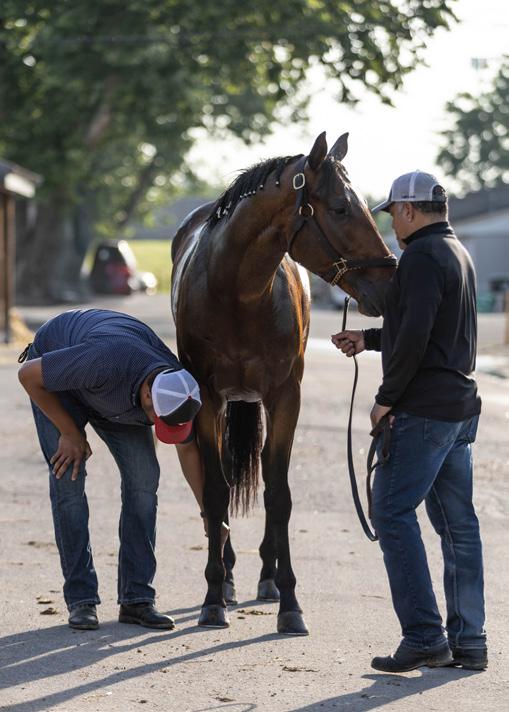

They also see genuine potential. In 2023, Simms saddled 78 starters who earned more than $400,000, both career highs. His current equine roster numbers at a dozen and, if he could get the stars to align just so, he would like to pick up a couple more claiming outfits, get his number of trainees up to the 3040 range, and start making some real noise with the 2-year-olds in his care.
“I don’t think I would want to be like those guys who have 200-300 horses,” he said. “Those guys do a phenomenal job, but I would prefer quality over quantity just because I want to be hands on.”
“His history with horses is equal to his passion for them. We are certain he will be a major player in American horse racing going forward,” Calumet Farm added in a statement.
With added time and chances will come more positive numbers. Regardless of the statistics, however, it is evident Simms is flourishing.



When his wife went into labor with their second child, the timing was such that they both agreed to swing by his barn on the way to the hospital to make sure the other youngsters dependent on him were well situated.
“And then on the way home, we stopped at the barn and brought the baby into the barn and made sure everything was good,” Simms said.
For the better part of the last decade, things couldn’t be much better for Simms. He has manifested the position in life he always dreamt for himself.
And he couldn’t be more at ease.
“I’ve had several opportunities to do other things, but the horses have been my passion, and I wake up every day and thank the good Lord that I get to pursue my passion,” he said. “I think there are a lot of really good horse trainers out here that just don’t have the athletes. I’m just hoping some of us can get some more opportunities.”

Sat, Sept. 27 Goodwood Stakes (GI) 3-Year-Olds & Up, 9 F
Sat, Sept. 27
Sept. 27
D Stakes (GII)
Sat, Sept. 27 Eddie D Stakes (GII) 3-Year-Olds & Up, 6.5 F (Hillside Turf) $200,000
Sat, Sept. 27 John Henry Turf Championship (GII) 3-Year-Olds & Up, 10 F (Hillside Turf)
Sat, Sept. 27 John Henry Turf Championship (GII)
Sat, Sept. 27 City of Hope Mile (GII)
Sat, Sept. 27 City of Hope Mile (GII)
Sat, Sept. 27 Unzip Me Stakes (GIII)
Sat, Sept. 27 Unzip Me Stakes (GIII)
Sun, Sept. 28 Santa Anita Sprint Championship (GII)
& Up, 10 F (Hillside Turf)
& Up, 8 F (Turf)
& Up, 8 F (Turf)
3-Year-Olds, 6.5 F (Hillside Turf)
Sun, Sept. 28 Santa Anita Sprint Championship (GII) 3-Year-Olds &
presented by Estrella Jalisco
presented by Estrella Jalisco
Sun, Sept. 28 Zenyatta Stakes (GII)
Sept. 28 Zenyatta Stakes (GII)
& Up, 6 F
Sat, Oct. 4 American Pharoah Stakes presented by 2-Year-Olds , 8.5 F
Sat, Oct. 4 American Pharoah Stakes
DK Horse (GI)
(GI)
Sat, Oct. 4 Oak Leaf Stakes presented by
Oct. 4
2 Year-Olds, 8.5 F
Oak Tree (GII)


Sat, Oct. 4 Rodeo Drive Stakes (GII)
Oak Tree (GII) Sat, Oct. 4 Rodeo Drive Stakes (GII)
Sat, Oct. 4 Chillingworth Stakes (GIII)
and Mares 3-Year-Olds & Up, 10 F (Hillside Turf) $200,000
and Mares 3-Year-Olds & Up, 10 F (Hillside Turf)
and Mares 3-Year-Olds & Up, 6.5 F
Sat, Oct. 4 Chillingworth Stakes (GIII) Fillies and Mares 3-Year-Olds & Up, 6.5 F $100,000
Sat, Oct. 4
5 F (Turf)
Sat, Oct. 4 Speakeasy Stakes 2-Year-Olds, 5 F (Turf) $100,000
Sun, Oct. 5
Beach Stakes (GIII)
8 F (Turf)
Sun, Oct. 5 Zuma Beach Stakes (GIII) 2-Year-Olds, 8 F (Turf) $100,000
$100,000
Sun, Oct. 5
Sun, Oct. 5 Surfer Girl Stakes (GIII)
Surfer Girl Stakes (GIII) Fillies 2-Year-Olds, 8 F (Turf) $100,000
Sat, Oct. 11 California Flag Handicap
Sat, Oct. 11 California Flag Handicap
Sun, Oct. 12 California Distaff Handicap
2-Year-Olds, 8 F (Turf) $100,000
3-Year-Olds, 6.5 F (Hillside Turf) $100,000
3-Year-Olds, 6.5 F (Hillside Turf) $100,000
Sun, Oct. 12 California Distaff Handicap Fillies and Mares 3-Year-Olds & Up, 6.5 F (Hillside Turf) $100,000
Mon, Oct. 13
Mon, Oct. 13 Swingtime Stakes
Sat, Oct. 18
Oct. 18
Oct. 19
Oct. 25
Fillies and Mares 3-Year-Olds & Up, 6.5 F (Hillside Turf)
Fillies and Mares 3-Year-Olds
hris Hartman took a pass on high school. Got promoted to groom before he knew how to muck a stall. Blew right past the assistant trainer’s position to trainer. And then, he leapfrogged $3 million in earnings, going from $2.9 million in 2021 to $4.2 million in 2022. Earnings in both 2023 and 2024 exceeded $5 million.
His story is at least as remarkable as his ascent through Thoroughbred racing and really, through life.
He went to work on the racetrack at the ripe old age of 11, drawing his first paychecks not from his trainer-father Stan, but Molly Pearson at Prescott Downs.
”Molly’s mother had actually made her hire me. She said, ‘You need to hire this boy, he needs a job.” It was an idea Pearson wasn’t keen on. She didn’t like the way he mucked stalls. When Molly told her mom of Hartman’s weakness with a muck fork and straw, her mother replied, “Well, that’s good. Then he shouldn’t be cleaning stalls anyway.’”
It was the beginning of his education in ground work. Hartman and Molly Pearson would groom horses together and give him valuable experience. She was, in Hartman’s words, “quite a caretaker of her horses. She’d have me rubbing their legs, putting jell on their legs and putting wraps on them.”
Hartman, 52, doesn’t remember life without horses. “I grew up with Thoroughbreds in the backyard.” His boyhood was spent with his dad at Turf Paradise, the Arizona county fair circuit, or Prescott Downs (now Arizona Downs).
The road called to Hartman at age 15 when an exercise rider going to Minnesota from Arizona asked him if he wanted to go along with him. His response? “Hell, it sounds like fun.” It was the beginning of a jaunt that took him from Minnesota to Tampa Bay Downs and back up to Kentucky. ‘Fun,’ though, was secondary for Hartman.
“I wanted to learn everything I could about a horse. So I sort of moved a little bit,” understating it considerably. He built his future watching those around him, studying individual horses carefully, and putting into practice something his grandfather, also a trainer, said to him: “You should always be able to learn. You can’t know everything about a horse.
“To this day, I try to learn all I can.”
Learning from his own horses began for Hartman at age 14 when trainer Michael Freeman at Turf Paradise agreed to sell him a horse named Jat Alane for $300. When Hartman showed up at Freeman’s barn - lead shank, halter, and money in hand - the trainer told him he had changed mind on the deal. It was a ruse that got Hartman fuming. He was mad enough to tell Freeman his dad had warned him about “people like you.” The trainer relented with the put-on and the nixed deal; he gave the “youngster,” as he called Hartman, the horse. The transaction probably was part of Hartman later running the shedrow for Freeman when he was 16.
Hartman’s next purchase came when he noticed a horse cooling out on the backside after a race. “He’d just ran and

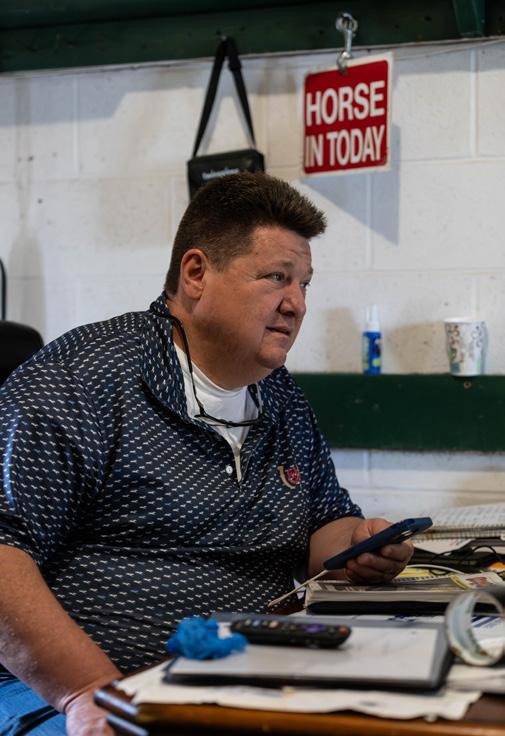
he was running off with the hotwalker, so I knew the horse didn’t give all he had in the race.” He approached the horse’s disgruntled trainer, Sheridan Majors, at probably just the right time. When Hartman asked about the horse, Fine Hostage, the trainer said, “‘Give me five-hundred dollars and you can have this s.o.b.’ So I said, ‘I’ll be right back.’ I went to my room and got the money and came back with it. That’s how I got him.”
Hartman trained the horse off the poor performance list and won the second time out on December 28, 1990 when he was 17. “He paid one-hundred eighty-nine dollars. I was training horses but I wasn’t old enough to have a license, so the horses were in my dad’s name.”
“When I was training that horse, I really wanted to figure it out for myself; was it really about the horse, or do you just need good horses, or do you have to go underneath somebody and be an assistant?”
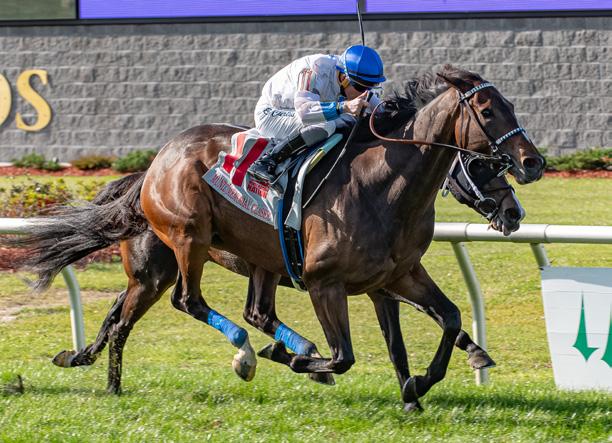
Fine Hostage, indeed, helped Hartman ‘figure it out’ with another win in his fourth start for him on February 2, 1990.
At the time Hartman was working for another trainer, Dale Hunt, who bridled at an employee with his own horse.
“I had told him, ‘I’m gonna’ get a horse.’”
Hunt apparently thought Hartman wasn’t serious. After the acquisition, the inevitable happened with Hunt. “He told me, ‘I don’t want you spending all your time with that horse,’ and I said, ‘Okay, that’s fine. I’ll give you my notice now. I’m going to be spending a lot of time with him. I guess you’re gonna need somebody else.’
“He’s like, ‘Whoa, whoa, you ain’t got to be doing it like that.’”
The exchange, at least for Hartman, was strictly business without emotion. “I wasn’t upset with the guy. I had a game plan.”
The plan included leaving the Southwest for a stop at Churchill Downs where Hartman worked for trainer Johnny Tammaro as night watchman. That job took him from Louisville to Saratoga. A thousand dollars was stolen from his wallet - this soured Hartman. From Saratoga he returned to Arizona. It was the jumping off point for him as a trainer.
“I had the mindset, I was going to learn either how to train a horse or go back and just get a job when I was really of age to do it. The whole goal was just to see if I can make a horse as good as they can be, if they are good enough to win, regardless of what the form looks like.”
The training regimen, the feed, the close watch on health and injury are, of course, the primary tasks of a trainer. But Hartman applied an intangible that is easily discounted or dismissed that made him successful, first in the Southwest and now at Churchill Downs. And it might also take him into the national spotlight in the future.
“I’ve got a love for horses. There’s no doubt about it. They’re magnificent to me. I love to see them in flight, just running. When you know that a horse just gives you everything they’ve got when they run, it does something for me. I was very blessed in the fact that I was born into something that I really enjoy doing,” he said.
The desk in his office at Barn 48 at Churchill Downs is strategically placed for him to look down the shedrow at every stall on one side of his barn.


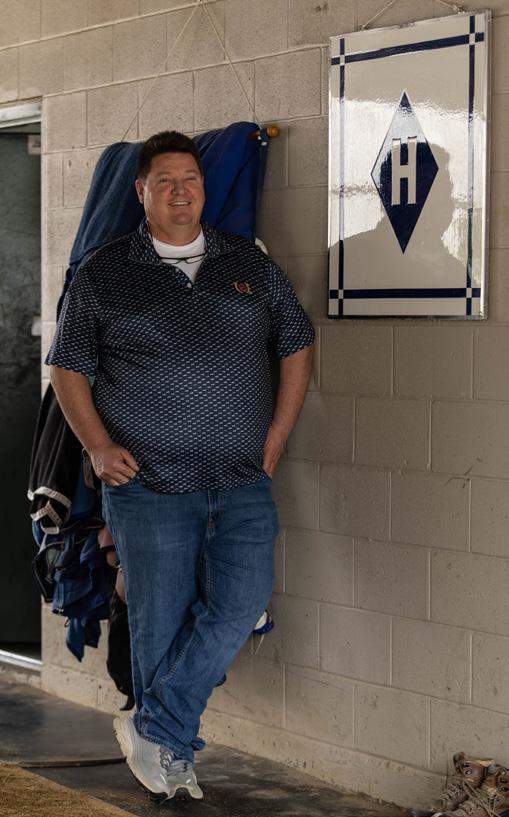

His absence of shyness around the entry box has paid dividends. His career win percentage is the same as racing luminary, trainer Steve Asmussen.
Despite that better-than-average win percentage, he dismisses statistics. “There are some real good trainers that are ten percent, twelve percent, and fifteen percent. I think people get a little too focused on the percent, not on the horse.” He goes so far as to say that a focus on statistics by trainers accounts for the increasing number of scratches and small fields. “They’re scared to run them because they want to keep their numbers up.”
“I spend a lot of time here at the barn just looking down the shedrow. At eleven o’clock here, we feed them, and all their heads start to pop out from the stall door. They know, eleven is ‘din-din’ time. They’ll start nickering when the feed starts coming. It’s a good time.”
If there is a favorite aspect of training for Hartman it is learning the personality of each of his horses.
He talked about a filly in his barn he described first as “very difficult” before amending it quickly to “super difficult.” How “super”? She had ripped off her hind shoes loading in the horse trailer on the way to Hartman’s barn at Churchill Downs.
A cold water spa just across from Hartman’s barn presented another difficulty for the filly. Hartman smiles recounting a recent incident.
“She goes in that thing all the time. About every third day, though, she decides she wants ‘more attention,’” as he termed it.
“The other day she was kicking, using her hind legs. I thought, ‘somebody’s going to get hurt.’ I came over and stood behind her and just started nudging her. She stopped and turned her head to look at me, turned some more to look at me, and then she walked right in.
“That’s just her. That’s what she does.”
Difficult or easy, all of Hartman’s horses run and run often, a reputation which he earned early in his career and still earns.
“Your magazine says ‘Trainer,’ right? It doesn’t say ‘Stall.’ I think you gotta’ run them.” At the time of writing, the 30 horses he has currently at Churchill Downs have made 56 starts in 38 days of racing—not that far from two starters per day.
The task, according to Hartman, is spending a lot of time determining where they run. Like any trainer, he likes to run his horses where they have a shot at winning but that doesn’t mean shipping a horse to a small track from Churchill Downs to improve chances of a win. “If I’ve got a horse that needs to be at Belterra (in Cincinnati) then they’ll be at Belterra,” making an oblique reference to trainers who shop for easy spots. He thinks it is one cause of smaller fields and more scratches at major tracks.
The path to the success Hartman has achieved to date began with his first venture to Lone Star Park outside Dallas. That’s where he introduced a newcomer, Joe Davis, to horse racing.
“He called me up and wanted to talk about getting in the game. He had never owned a horse.
“He was the first guy that really invested in a lot of horses with us, and that probably changed the direction for me.” Three straight wins for horses with Davis’ first three starters for Hartman didn’t hurt in cementing the relationship.
“Before, I was just plugging along, trying to get us in the Midwest.” Hartman has had as many as 45 horses owned by Davis in his barn through the years.
The other major boost to Hartman was giving Oaklawn Park a shot in 2013. In 77 starts in Hot Springs, Hartman horses won 16 races for an impressive 21% win rate and 12th place in trainer standings for the meeting.
The move was the beginning of “getting better horses and new owners.”
Of course, that doesn’t just happen. “If you’re winning races, owners will come.”
One new owner Hartman met at Oaklawn, James Driver, brought him 15 horses that the trainer knew were well-bought, solid horses.
“He had replaced his previous trainer and called me and said he wanted to make a switch,” recalled Hartman. “I was a little bit surprised. I thought they had a good thing going myself.
I said to him, ‘Well, maybe you’ll work it out with him.’
“I try to quiz someone a little bit, you know, to see what’s going on. Are they firing their previous trainer because, ‘I don’t like the way he picks his races,’ or whatever. I’ll ask, ‘Well, where do you think they should run?’ And then you might find out the reason why they’re firing the trainer is because they want to run them in allowance races. Well hell, it ain’t gonna be much different with me. I want to find out what the guy’s doing. What’s the thinking? Is he firing the trainer just to make a change or is there a legit reason.”
This may go a long way in explaining the long relationships he has had with key clients and the success he has brought them. “Joe Davis told me, ‘Chris, we’ve been together longer than two of my marriages.’”
From Oaklawn, Hartman, a noted storyteller on the backside at Churchill Downs, employed ‘a little bit of convincing’ with some of his clients to give Kentucky and Churchill Downs a try in 2015.
“We had twelve horses for Driver and I thought they’d fit here,” said Hartman. He is still traveling the Churchill Downs-Oaklawn Park circuit each year. He also still has horses from both Davis and Driver.
What is next for Hartman? The last two $5 million-dollar years bode well for the future.
“You always have to go forward. I’m just trying to get better horses.”
The challenge he embraces to get the most from horses is something that has never left him. “I’ll be honest, if I had fifty-two stake horses in the barn right now, and there’s fifty-four stalls, I’d still have a couple claimers. I love trying to figure them out. Some people like to mess around with old cars, and I like to mess around with horses.”
And making them, of course, as good as they can be.
Stay tuned.


When Funny Cide rolled into the 2003 Kentucky Derby with a school bus full of New Yorkers, few in Sackatoga Stable could have anticipated the ride ahead. One Derby and Preakness victory later, the “Gutsy Gelding” and New York-bred drew new attention to the state’s breeding programs, including the breeder and owner awards as well as a series of stakes races specifically designated for these horses.
Twenty-two years later, a collaborative effort by the New York Racing Association and the state’s breeders’ organizations with legislative backing have revitalized the sport in the state. The result is a reinvigorated breeding and racing industry in one of the country’s oldest circuits, where a new Belmont Park and forthcoming purse parity make the Empire State’s future a bright one.
New York has long been in the business of racing, starting in the colonial era beginning in 1665 when Governor Richard Nicolls built a track on Hempstead Plain on Long Island. After

the Civil War, the state emerged as the sport’s refined Eastern hub, while Kentucky was considered the upstart, rustic West. As the Triple Crown era took hold in the 20th century, racing expanded across the country with California, Florida, and other states growing the sport and the competition for horses to fill races. With breeding increasingly concentrated in Kentucky and Florida, individual states needed new ways to support the farms producing horses in their area. One way they found was through breeder incentive programs.
Established in 1973, the New York Thoroughbred Breeding and Development Fund (NYTBDF) distributes money in the form of breeder, owner, and stallion owner awards of more than $15 million. Funds come from both pari-mutuel wagering and Video Lottery Terminals at Aqueduct’s Resorts World Casino New York and at Finger Lakes Race Track. Breeders, owners, and stallion owners are rewarded when their New York-bred horses race and win in the state. In 2024 alone, over $16.5 million in incentives were paid out.

“[The Fund] incentivized people to get into the business. It gave people who had land in the Hudson Valley more incentive to keep it in agriculture. It was a very insightful piece of legislation that they put together,” long-time breeder Joe McMahon observed. “As the handle grew, those awards grew. There was money to spend. The legislation is written so that all the money has to be dispersed every year. It’s about 20-some million dollars in awards alone that the fund administers.”
Funny Cide’s storybook journey through the Triple Crown brought new attention to New York’s breeding programs, spotlighting operations like McMahon’s, and proving the caliber of horse state-bred programs can produce. “Winning the Kentucky Derby gave a lot of additional legitimacy to the New York-bred program. Everybody’s dream is to win the Derby and Funny Cide did that as a New York-bred. And I think a lot of people will say that it was a big factor in some of the expansion that happened after that,” Jack Knowlton of Sackatoga Stable echoed. Sackatoga’s success became the state’s best advertising for not only its breeding program, but also for the expansive benefits that come with it.
Funny Cide’s impact extended beyond New York, inspiring then–Kentucky state senator Damon Thayer to introduce legislation in 2004 establishing the Kentucky Breeders Incentive Fund, aiming to replicate the success of New York’s program in the Bluegrass.
“New York-breds have proven themselves to be able to win anywhere. But as someone who participates in a racehorse partnership, for New York owners to know that there is a strong New York-bred program to run their horses in gives them a level of stability,” Thayer shared. “And it’s easier for them to make decisions on an investment that doesn’t give you a first chance to pay off for three years, knowing that they’re going to have those opportunities to race regularly in that state-bred program.”


To continue the momentum generated by Funny Cide, New York, through the New York Thoroughbred Breeders and the New York Racing Association, focused on increasing payouts to breeders, owners, and stallion owners. Since 2011, the program has issued payouts more frequently than other states—every two months— and in 2022, increased breeder award percentages based on whether a New York-bred is also New York-sired or by an outof-state stallion. Tables 1 and 2 outline current payout rates. In addition, stallion owners receive 10% of purse money earned for first through third place by New York-sired state breds, with a $10,000 cap per award.
“It’s a significant amount of money. When the win take home is over $50,000 and you have a New York-sired New York-bred, it’s going to get a 40 percent award on that. So that’s $20,000 in most cases,” McMahon pointed out. “Even if you’re second or third,
you’re talking about a 20 percent straight award. That’s what sets us apart from Florida, from Kentucky, from all the other states.”
The frequency of the payouts also makes New York an attractive place to breed and race. “People go, ‘Oh, I got this just in time. I’m going to pay my property taxes.’ Or they’ll say, ‘Oh, this is going to go towards my stud fees or my board bill,’” said Tracy Egan, NYTBDF Executive Director. “That money in motion comes back into the equine industry in New York and helps us, helps the entire equine industry.”

The changes that the NYTBDF and the NYTB have instituted over the last few years have made breeding, buying, and racing even more profitable and attractive. Fifty years after the fund’s creation, as Najja Thompson, NYTB’s Executive Director, observed, “We thought this was the most opportune time, in a time that’s really of concern for our industry overall, that we can make sure that our state is able to make that impact in producing and increasing our foal crop.”
Despite a declining North American foal crop, dropping from an estimated 17,500 in 2023 to 16,675 in 2024, New York’s foal crop grew from 1,281 to 1,530 in the same period. This growth highlights the success of breeder incentives and the organizations’ understanding of how to support farms in breeding and racing New York-bred foals.
In addition, under the new rules, a qualifying mare purchased in foal at auction for $50,000 or more can become New York certified “if the mare is present in New York State within 15 days after the sale is concluded, the foal from public auction mare is foaled in New York State and the mare thereafter is continuously in residence in New York State from within 120 days after her last cover in the year of conception of another foal and remains in residency until foaling” per the NYTBDF’s website. The mare can retain her New York residency even if she travels out of state for auction, provided she is back in the Empire State within 15 days of the auction’s end.
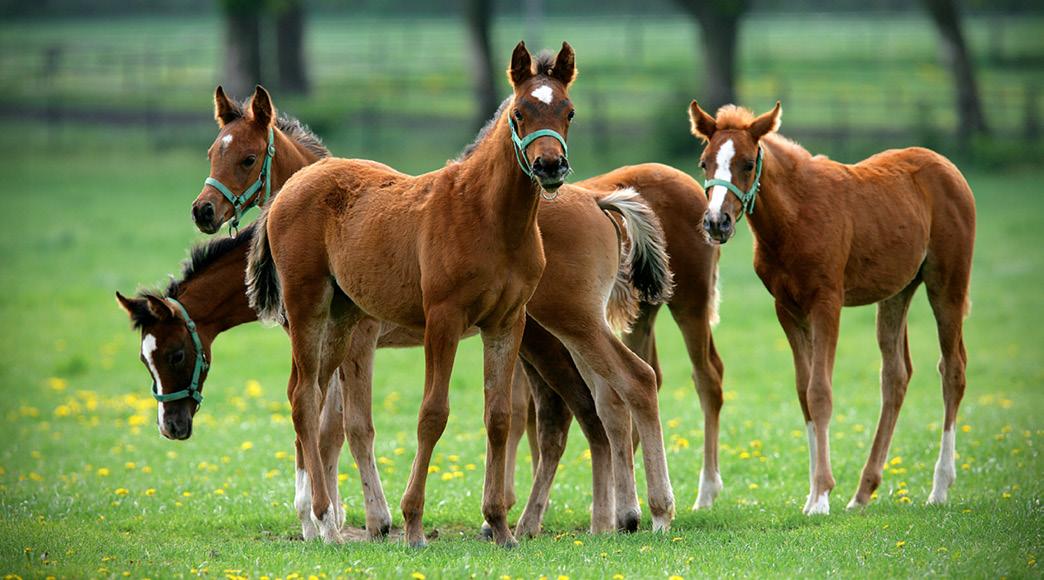
This positive trend in foal numbers comes not only from the actions of the NYTB and the NYTBDF but also from NYRA’s commitment to supporting and growing the state’s horse population. Through its carding of state-bred races and planned purse parity, the nonprofit entity behind the sport at Aqueduct Race Track, Belmont Park, and Saratoga Race Course has reinforced this historical circuit’s vital role in North American racing.
The success of New York’s breeding programs is also seen in the sales ring. As Fasig Tipton’s Evan Ferraro observed, “You see more national stables and trainers, coast to coast, that are focusing on them now as opposed to just the New York guys in the past. As the quality of the horse being bred has gone up, obviously, the sales prices have gone up. And also the overall product and what breeders and sellers are bringing to market, it continues to ratchet up to be a higher level.”
Breeder incentives are not the only driver of the state’s breeding and racing revival. NYRA has also introduced its own incentives to support the stables and farms that supply horses essential to their racing product.
Support from (NYRA) comes in the form of races exclusively for horses bred in New York; in 2024, state-bred races comprised about 25-30 percent of its daily cards, with 548 races worth a total of $42,817,000 in purse money. As part of its ongoing commitment, NYRA has pledged purse parity beginning with New York-bred two-year-old races in 2026 and extending to all races in 2027. This coincides with the reopening of a newly rebuilt Belmont Park that will feature a synthetic surface. The move is expected to boost the value of New York-breds by more than 15%.
For example, the purse for an open company maiden special weight at the Belmont at Aqueduct meet was $85,000 while the

ABOVE: August’s Fasig-Tipton New York-bred sale has seen an uptick in sale prices in recent years, making it very competitive to buy New York hips.
same race restricted to New York breds paid $80,000. By 2027, the same races would carry the same purse, regardless of their conditions. For owners of New York-breds, Sackatoga’s Knowlton believes this will be a game changer: “I think that they’re going to be able to attract a lot more owners with a new Belmont, and hopefully, a lot of those owners are going to be the people that are involved in New York.”

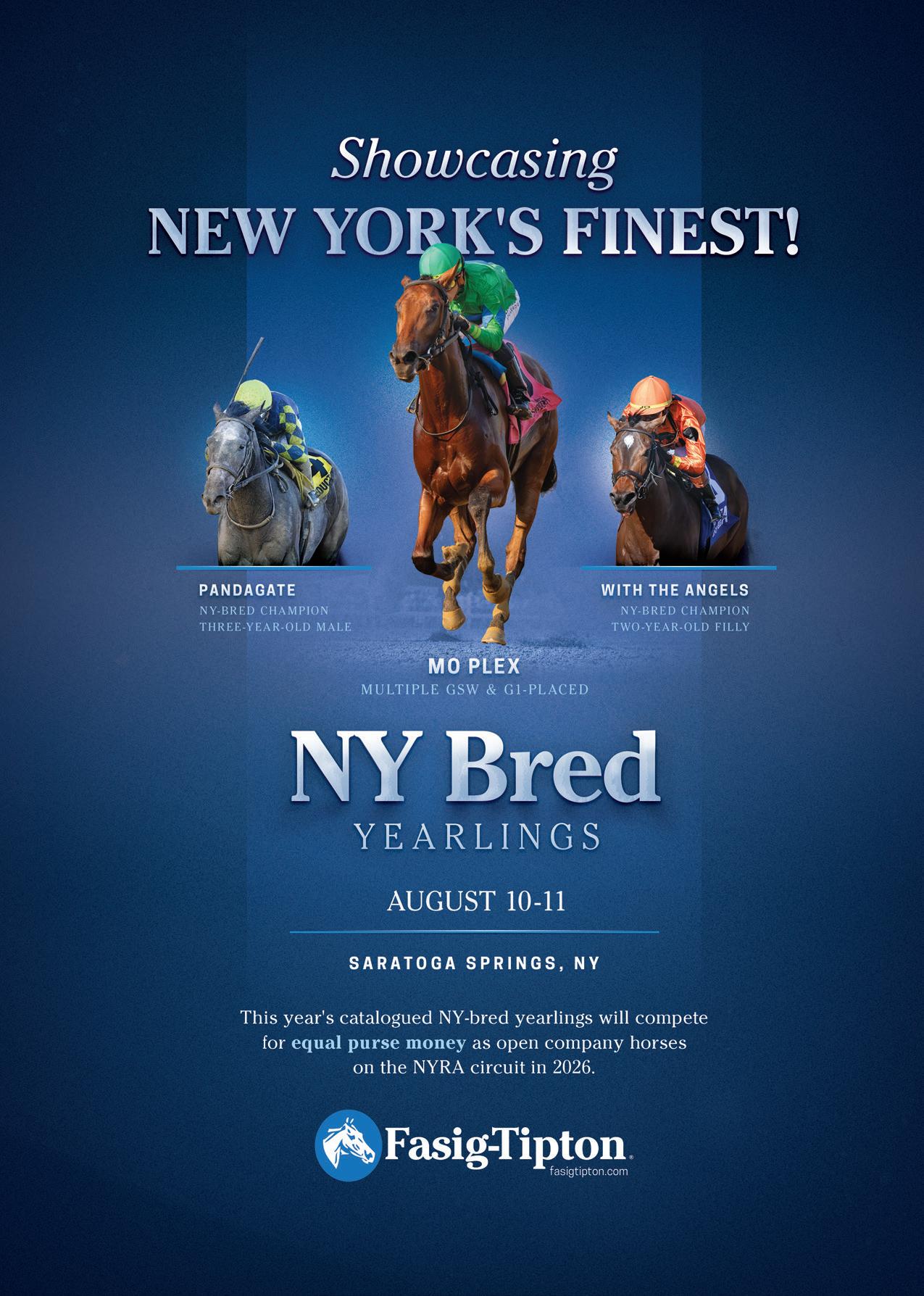
For trainers like David Donk, whose stable is currently about 60 percent state breds, those increased payouts mean more money for everyone involved: “At the end of the day, we’re working off of commission. If the owner is going to run for a little more money, it means the trainer is going to run for more money. In that aspect, we’re all going to benefit from it.”
This also means that these New York-sired state-bred horses are going to be a hot ticket: “Now, with this purse parity coming into effect, that’s a huge deal,” Ferraro shared. “These yearlings that we’re going to have at the sale this year will all be eligible. And I would expect that they’ll really be highly sought after.”
“The biggest difference you’re seeing that is at the [Fasig-Tipton] Saratoga New York bred sale in August,” Donk shared. “You’ve seen an uptick in the last few years in the sale prices. So it’s been very competitive to buy New York hips. You have the Select Sale the week before, and you’re thinking, ‘there’ll be a little bit of a downturn to the next sale.’ Unfortunately, it might be the reverse for us value buyers.”
NYRA’s support of the state’s breeding through both the condition book and the purse payouts is a continuation of the investment highlighted by Belmont Park’s reconstruction.
“First and foremost, without quality horses to run our racing programs, our overall product that we put on track suffers,” Andrew Offerman, NYRA Senior VP of Racing & Operations, observed. “It’s important that we focus on more than just the business of the racetracks. It really does incorporate breeding and the other aspects of the business that go into that overall economic impact.”
As Thayer pointed out, “if you’re NYRA and you’re trying to fill races on a year-round basis, you have to have that strong, what I call native horse population – in this case, New York breds – to sustain a couple of hundred days of racing every year. And they got that in spades.”
Combine NYRA’s support for New York-bred races with NYTBDF incentives, and breeding or racing a New York-bred –especially one by a New York-based stallion – can be more lucrative than with a Kentucky or Florida-bred. NYRA’s Stallion Stakes series and the NYTBDF’s Stallion Owner’s Awards provide added incentives for farms like McMahon Thoroughbreds (home to the state’s leading stallion Central Banker as well as Solomini), Sequel


Stallion Station, (standing graded stakes winners Keepmeinmind and Fire at Will) and newcomer Ironhorse Stallions, whose Bucchero is a leading sire of synthetic runners.
Harlan Malter, one of the partners behind Bucchero and Ironhorse, saw that moving the stallion from his original home in Florida to New York was right for both his horse and the state’s breeding program.
“I think New York is heavily on the rise. We just felt that with Bucchero’s success, when we actually made the decision, the synthetic had not really been lined up. It’s obviously worked out well. He was leading synthetic sire in the United States last year. He’s basically one of the top ones this year also. It was the right place for us to bring him,” Malter shared. “They have a huge opportunity in New York. The breeders, the horsemen, NYRA, it’s all been building to this moment.”
The additional monies from the Stallion Series races as well as Stallion Awards are in place to incentivize breeders to breed their mares to the state’s slate of stallions, but about 60 percent of mares still go out of state to be covered. This highlights New York’s need to continue recruiting stallions. “We just need to slowly elevate the quality of the stallions to give breeders the ability to both sell into this commercial marketplace and then give owners/breeders the ability to go, I can beat anybody in the gate with me with a New York sired horse,” Malter observed.
Echoing Malter, Fasig-Tipton’s Ferraro understands that “the more quality stallions that you can get to the state, the better off the program is going to be, especially with the aid of incentives like this New York Sire series.”

2024 Top Ten 3-Yr-Old NY-Bred Money Earners Previously Sold at Yearling Auctions: Average Sale Price: $93,900 Average Career Earnings through July 1: $168,749 (EQUIBASE.COM, 7/1/25) In 2024, NY-breds ran for total purses of $42,817,000, with the new program anticipated to increase NY-bred overnight purses by 15% compared to 2024 purse levels.

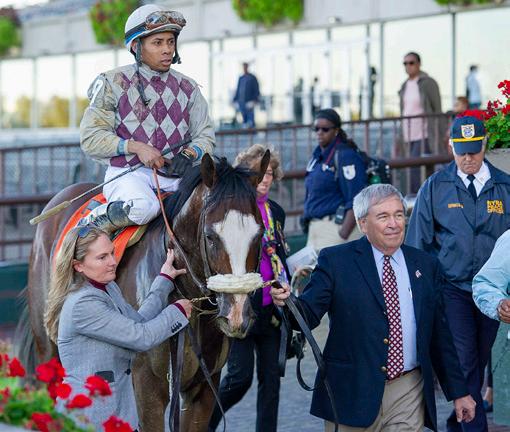
In addition to new stallions, NYRA and the breeders’ organizations see that the state will need more owners to race these growing numbers of New York-bred horses. As Knowlton observed, “you get more owners, you get more horses, and you get more people to the racetrack. To me, it revolves around attracting additional owners and additional capital into the game. We’ve done it in our small way. We’ve got, as I said, around 120 partners. They put in money, and they come to the track, and they gamble. There’s no better way to improve your product and find more revenue than people in ownership.”
Belmont Park’s scheduled 2026 reopening serves as another opportunity to bring more owners to the state. With the new racetrack comes purse parity and the chance to “participate in the sport on the biggest stage. You have an opportunity when a new Belmont Park is complete to visit both the newest venue in the
country, but also the most historic, continuously operating facility in the country is Saratoga,” NYRA’s Offerman observed. “You really get everything from the entirety of the historical perspective of horse racing within the state of New York. And then you’ve also got the benefit of what we do not only within the facility for the ownership experience, but also the fact that we broadcast more hours on national television than any other racetrack operators.”
As construction continues on a 21st-century edition of Belmont Park, one prepared to support year-round racing in the Big Apple, the racing in this historic circuit is as rewarding as ever. “For the long term, 12 months a year, New York and Kentucky are going to be the pillars that we all stand on,” Malter predicts.
“Obviously, I’m a Kentucky-first guy, but it’s important for the Kentucky breeding and racing industry for there to be strong regional markets like the one in New York,” Thayer echoed. “I think it’s so critical that New York has a vibrant, year-round circuit. A strong state-bred program is critical to year-round racing in a place like New York. So I’m happy to see it, and it’s good for the industry as a whole.”
The current state of the sport in New York shows “that racing is popular, and people will support it in New York State. Next year, we’re going to have Belmont opening. We’re going to have the Breeders’ Cup back in 2027,” McMahon shared. “We have a friendly government relationship with racing. The Breeding and Development Fund has done an excellent job of encouraging people to keep their farmland as farmland and to get into the horse business and we will continue to do a great job on those fronts.”
“I think the quality of the New York product right now is the strongest it’s ever been,” Ferraro observed. From new facilities to growing incentives to rising foal crops, American racing is in a New York state of mind, and if you can make it there, truly you can make it anywhere.




Kerckhaert Race Plates continue to be the most widely used in the racing market. The quality, design and shape options are key reasons for their popularity. Consistent availability and rapid work to have all the HISA approved styles (especially the low toe hind) has also contributed to the success. If you haven’t heard – the first-place winners and second place finishers in all three Triple Crown races were wearing Kerckhaert race plates!




WHAT
WHY

Chelated minerals, commonly known as ‘organic minerals’ have been around since the 1980s and were quickly adopted into feeds for production animals as benefits relating to health, production and physical gains became apparent through a growing body of research and proven results on farms.
Early in the 1990s organic minerals appeared in horse feeds with most brands adopting a partial replacement concept, using a low inclusion of organic minerals alongside inorganic minerals.
By early 2000 researchers began querying if diets could be reliant fully on organic minerals, working on the basis that ‘nature identical’ minerals would require lower feeding rates and could still deliver the same level of performance whilst also benefitting the environment.
Fast forward to today and some feed companies, including equine, are now operating with organic minerals only. Is this the future of mineral nutrition for racehorses?
What is an organic mineral and where do minerals come from?
Most mineral additives come from inorganic compounds such as oxides, sulfates, carbonates and phosphates. Interactions between inorganic minerals combined with lower levels of digestibility means inclusion levels are often high in feeds to ensure dietary needs are met. Variability in forage is also a factor in why mineral levels often run well above recommended intakes as well as catering for the ‘more is better’ mindset in the marketplace.
Over-formulating and over feeding of mineralized feeds or supplements does not get better results. In fact, quite the opposite. There is a fine balance between minerals, which actively compete with each other for absorption in the body. Then there is the question of energy efficiency as processing excessive and unnecessary nutrients requires energy within the body.
Organic minerals offer an interesting alternative, having a greater bioavailability, not competing for the same absorption sites, reducing effects of interactions, and wastage of nutrients excreted into droppings. The excretion of minerals was a key driver behind the increased use of organics in the agri sector as the impact of farming on the environment continues to be closely scrutinized. The benefits of using organic minerals aren’t just about animal health and performance, they are also about environmental responsibility.
Organic minerals are trace elements, also known as micro minerals, that are complexed or otherwise associated with an organic molecule. Most commonly referred to as chelated minerals. The term organic mineral is used quite
broadly, and there are several different types of organic minerals used in animal feeds. Copper, zinc, manganese and iron are available in chelated form, whilst selenium is available in organic yeast.
Creating an organic mineral is a process of reacting the inorganic mineral salt with a suitable non-metal entity known as a ligand. Ligands are mostly single amino-acids or small peptides (chains of amino acids). Once bonded the mineral becomes part of a biologically stable, and more available structure.
The key word is stability as this influences how that mineral behaves when fed, as the digestive system presents several challenges, including varying levels of pH. As a general rule, minerals organically bound with peptides (amino acid chains), that have a greater potential to form bonds, create more stable organic minerals than those based on a single amino acid.
Chelation of minerals is the process used for zinc, copper, iron and manganese. Selenium is a little different, belonging to a different group of elements, that are difficult to chelate in the same manner. For that reason, organic selenium is also derived from selenised yeast, a form commonly used in equine feeds and for which equine specific research is available.
Mineral stability and resilience to some of the challenges of the digestive tract is one part of the success story behind chelated organic minerals. Binding with amino acids also means that organic minerals utilize different pathways for absorption compared to inorganic minerals. This improves absorption and reduces competition with other minerals.
As the ‘what goes in’ with organic minerals is more stable and is easily absorbed there is less needed to meet requirements and still provide benefits to health and performance. On a feed tag or supplement label the number might look lower but the efficacy is greater.
When reviewing your feed choices and looking at all the numbers it is worth asking the question as to what form of mineral is being used, not just the milligrams per kilogram value in the brochure. The mineral source is not always declared on a website or datasheet but by law is noted on the feed label in the additive section, so it is worth walking out to the feed room and taking a look.


The whole concept of using chelated minerals is to “do more with less.” That is the challenge as Steve Elliott, Global Vice President of Companion Animal at Alltech describes it, and what Alltech have set out to prove is possible.
There are multiple papers on the benefits and efficacy of organic minerals in farm animals. There is however much less equine specific research available. That does not mean organic minerals aren’t good for horses, or don’t work as well, it’s just that horses aren’t generally for eating (which influences spend on research) and they are harder to research.
What research likes is specific measurables that can easily be linked back to a change in diet, such as live weight gain or milk production. As we don’t fatten horses to eat, or use them for milk, the measurables in horses are harder to work with. Increased performance has too many other variables involved, such as ground conditions, rider etc. As such, we have to work with a smaller pool of data on horses specifically and combine that knowledge with other species with similar digestive systems.
Inclusion of organic chelates in animal feeds has been a common practice for the last 40 plus years. Typical inclusion levels are 30-40% of the total mineral being provided as organic, with the remainder as inorganic. At that level there is plenty of research to show a positive effect. Inclusion levels much below that rate of inclusion are questionable. Just because a feed or supplement says ‘contains chelated minerals’ does not guarantee they are included at a meaningful or effective level.
More recently the use of organics only has been the area of interest for research. This is an area Alltech have been heavily involved in, and at present have conducted 253 trials, resulting in 131 peer-reviewed papers.
One of the key questions when considering organics is how much less can be fed versus traditional inorganic minerals in the daily diet. Just how much better are they? From other species the answer is a whole lot less, with research into poultry and swine showing less than half the amount is needed compared to inorganics mineral sources.
Whilst there are no feed tables specifically for horses referencing organic mineral and inorganic mineral requirements there is enough evidence to give confidence that organic minerals could be, and already are being, used as the sole micro mineral source for horses.
Horse feeds are typically generously fortified or over-fortified against requirements. For horses in training where feed intake is easily 4 times that of a sport horse the daily intake of copper, zinc, manganese and selenium is often significantly above requirement. For example, horses in training are often consuming copper at 250-300% of requirement.
With the source of copper being either dominantly, or entirely inorganic, the level given is not necessarily, in fact it is quite unlikely, to be twice or three times as good as feeding the required level. High intakes will result in greater losses into feces, having little benefit to the horse, and having a negative impact on the environment.


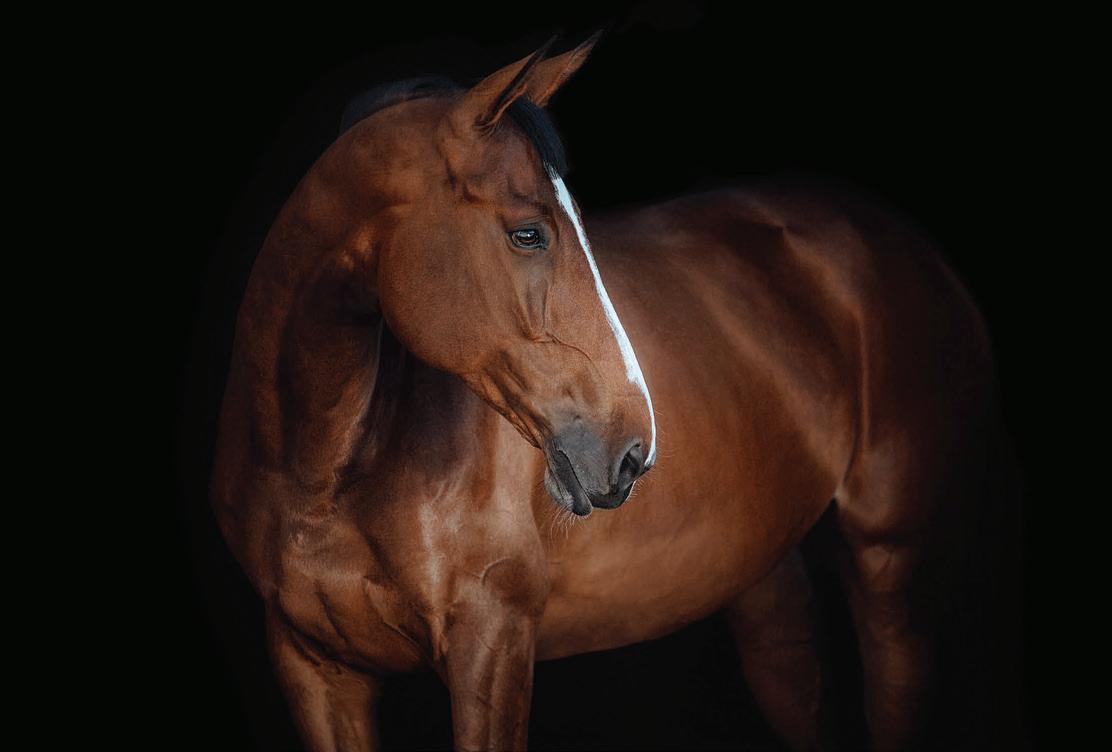

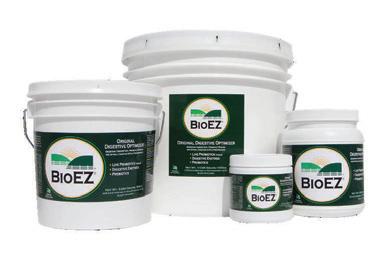
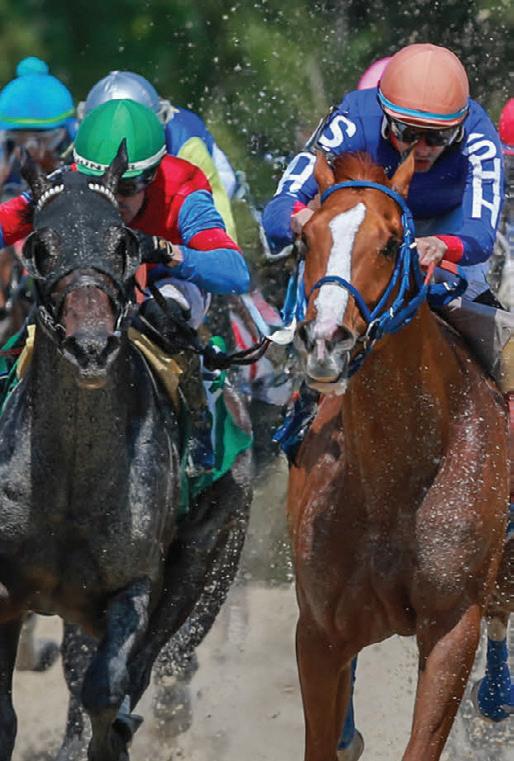



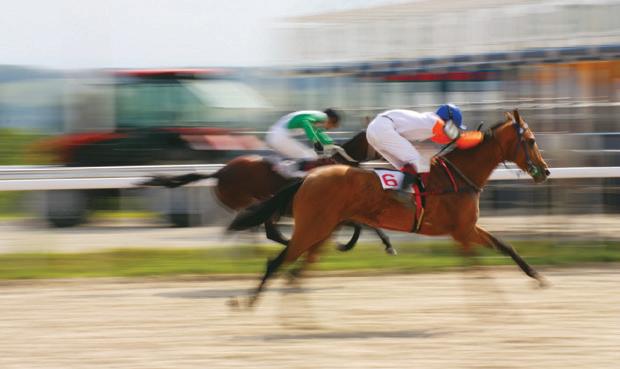
There are equine feed companies already working with organics only, including Guabi Horse Feeds in Brazil and McCauleys feeds in the USA. Working closer to daily requirements, rather than high dosing, and using organic minerals only, these companies are proving organics are a real option for performance and racing horses just as much as they are for other animals.
Minerals such as selenium, manganese, iron, copper and zinc are added to feeds and provided in supplements for two reasons, to address the shortfall and variation in mineral content from forages, and to provide levels above basic requirements with the aim of enhancing performance or using nutrition as a therapeutic tool.
Organic mineral research orientates around improved uptake and efficacy within the body, trying to improve as an aspect of performance related to that mineral. Each mineral has its own role in animal health.
Selenium has many roles in the body. Primarily, its role in regulation of the antioxidant system. Following the uptake of selenium by the body, selenium becomes incorporated into numerous selenium-dependent enzymes and proteins, which play many major biological roles.
Selenium is also a mineral which is regulated, having a maximum permitted level in the daily diet for horses, as whilst being beneficial selenium can also be toxic. When looking at feeding horses in training additional selenium should only be given if feed and forage levels have been assessed and factored into the daily intake.
Major biological roles of selenium-containing proteins SELENOPROTEIN PRIMARY FUNCTION
Iodothyronine deiodinases
Glutathione peroxidases, Thioredoxin reductase, Selenoprotein P, Selenoprotein W Antioxidant Properties
Sperm capsule selenoprotein Sperm Structure
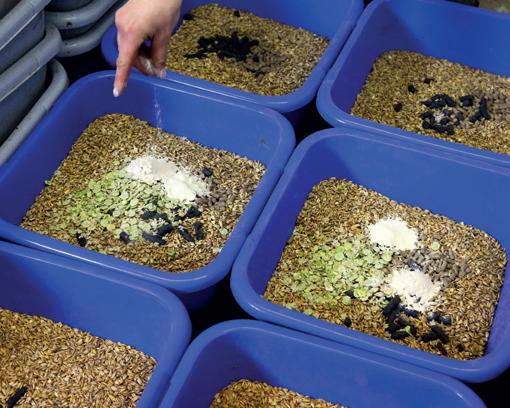
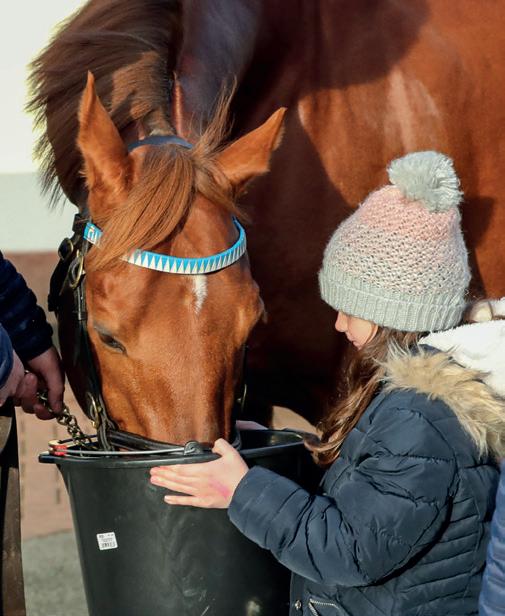
Research into organic selenium benefits for poultry, swine and cattle includes:
• Improved disease resistance
• Improved antioxidant defense
• Improved retention of selenium in muscle and tissue
• Improved fertility
• Improved growth rates
• Improved selenium content in milk and colostrum
Equine specific research has also shown the same effect on mare’s milk and colostrum.
Each of these minerals has a role to play in health and performance. When researching efficacy for organic minerals these are often grouped in research as the objective is to determine if replacing this group in part or in full improves the finished feed .
Copper is one of the most important micro minerals for horses. It has many key roles including, mobilizing iron stores, correct functioning of enzymes, maintaining elastic tissues, proper skeletal growth and development, and its role as an antioxidant.
Zinc has a broad reach in the body, being an enzyme activator or co-factor, as well as being part of over 200 proteins. Zinc is required for normal functioning of insulin and for normal glucose utilization. It is also important for a functioning immune system, healing of wounds and neurological functions.
Manganese is involved in bone formation, fatty acid synthesis and amino acid metabolism. Unlike copper and zinc that are naturally low in forages, the level of manganese can be sufficient to meet daily requirements. Variability in levels found within forage is high and supplementation is common practice to cater for this risk.
Iron is part of hemoglobin, the component of red blood cells that allows oxygen to be carried to tissues. Iron deficiency is rare as the horse has a high ability to conserve iron. Approximately 67% of the body’s iron is stored in red blood cells in the form of hemoglobin.

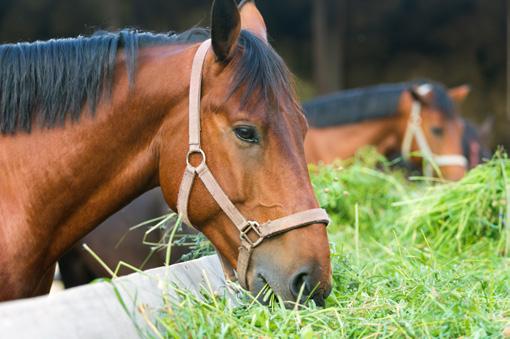
Red blood cells are formed within the body and remain in circulation for around 150 days. When they die, the iron they contain is recycled and used to build new red blood cells. As such, there is rarely a time where iron is lost from the body. The exceptions to that being horses with high worm burdens, horses with gastric ulcers that cause blood loss, and horses suffering from EIPH (Exercise Induced Pulmonary Hemorrhage). Iron is found in good quantities in feed ingredients and forages, sufficient in most cases to meet requirements. Iron is often added to feeds at low levels to ‘top-up’ naturally occurring iron.
Research from other species including farm, aquatic and dog show, organic minerals when fed in combinations, have benefits including:
• Improved bone mineral content
• Increased growth rates and weight gains
• Improved milk and colostrum mineral profile
• Increased total antioxidant capacity
• Improved gut morphology
• Improved availability in the presence of antagonists
In horses, a study looking at the influence of oxalates, a substance that reduces calcium uptake, researchers were able to demonstrate that organic minerals were better able to prevent bone resorption compared to inorganic minerals. Diets contained organic copper, zinc, manganese and selenium.
One of the achievements of organic minerals is reduced mineral leaching, an important consideration for farm animals. Alltech have investigated this in horses also, looking at the effect of their organic minerals (Bioplex) on fecal mineral excretion and fecal mineral leaching potential.
In this research horses were fed one of three diets, a standard diet with no mineral supplementation (CON) or diets containing either inorganic (ING) or organic added minerals (ORG). In both diets with added minerals there were increased mineral levels found in droppings. The diets were supplemented to be higher than requirements (120-380% NRC), which replicates what is commonly found in industry feeds. The organic zinc and copper levels found in the manure were lower than inorganic levels, demonstrating better uptake in the body.
Both supplemented diets resulted in increased levels of phosphorus leaching from the manure, although the organic mineral diet resulted in numerically lower levels of phosphorus leaching than inorganic. The same pattern was seen for sulfur.
Manure from all diets was then used to grow tall fescue grass to determine if the diet influenced grass growth. Grass was grown using the manure from the horses fed the three different diets, with water on its own (WAT), and a liquid nutrient solution (NUT).
Grass grown with manure from horses fed diets supplemented with organic minerals (ORG) had 16% greater biomass than grass grown with manure from diets supplemented with inorganic minerals (ING).
Plant Biomass – Organic matter derived from plants, containing stored chemical energy from the sun, generated through photosynthesis.
Whilst the majority of research is from other species the science is sound, and the benefits found are equally relevant for horses in training. The majority of feed companies already use chelated minerals in their feeds to provide a proportion of minerals in this format, albeit at varying levels. What is less common, at least in equine, is the total replacement of trace elements with organic formats only, but it is being done and done successfully.


The art of yearling preparation in Thoroughbred racing has undergone remarkable transformations, yet has always kept the same golden ideals when preparing the world to see the next crop of elite equine athletes.
Yearling preparation, as many come to find it, marks the start of a horse’s journey to create themselves; and along with that ideal, create an impact on anyone that lays eyes on them.
Where once young Thoroughbreds were given very minimal handling before they were sent off to the sales ring or showed off to buyers, today’s modern equine athletes are blessed with the technology of advanced balanced nutrition, state of the art biomechanics, measured conditioning, and even mental training. They are handled everyday as newborn foals to prepare them for what they are to face in yearling preparation. In a way, many could say that yearling preparation can even start at birth.
With the growing influence of data analytics and advances in veterinary recommendations and technologies, today’s yearlings are sculpted for not only physical conformation, but also for the earliest of maturity and trainability. This has caused the bar of the overall buyer expectation to be raised higher than we have ever seen it. A shift like this has certainly reflected the industry’s heightened competitiveness, and the ever-increasing demand for horses who are ready to perform the second that the hammer falls. It has always been what buyers have aspired for, but the definition on what it should look like has changed significantly over the years.
Prepping a thousand pound, elite athlete that can reach speeds of up to forty miles per hour is never an easy task. In fact, the yearling prep game has developed much more on the individual level simply because we have the technology to do so. The goal to create a profile that ‘checks all the boxes’ for buyers is the same goal no matter what level you are in the business. Denali Stud, a leading consigner at every major yearling sale, has set an example of what equine excellence should look like.
Denali is responsible for bringing some of racing’s best, like Kentucky Derby winner Animal Kingdom, Kentucky Oaks heroine Malathaat, and champion two year old colt and top sire Uncle Mo. Perhaps there is a method to their madness, as Yearling and Sales Manager Donnie Snellings has integrated an articulate schedule for his horses to be at their best when they are presented to the world for the first time. Since joining Denali in 2009, his process of using modern day techniques to prep Denali’s star studded yearlings has brought generations of success.


His watchful eye of forage intake, joint evaluation, and overall development of confirmation is prominent throughout the season. Fillies are more so in groups, and colts are put in individualized paddocks due to temperament. Snellings adds that the colts are a bit more active than the fillies; who in contrast tend to immediately start grazing as soon as they get turned out with their group. “There’s always the one you’re trying to get the belly off of, so I may swim those. Those with bad confirmation I usually will walk only. Some will walk, and some will jog. It is all based on what I see in them every day on the farm.”
This individualized look into using modern exercising technologies is prominent in the current yearling market. The patterns of walking and jogging either by hand or by machine, along with swimming in equine engineered pools polishes Denali Stud’s yearlings to look their best at the sales.
That is quite the contrast of what yearling preparation used to be. “About forty or some years ago in the early eighties, not a whole lot of prep went on at all. Horses were still groomed of course, but there was never really an exercise program at all. The physical demand wasn’t as great as it is today. Mostly, they were kept in until the sale”, Snellings says.

The contrast between these two eras of yearling prep is driving the new vision that we see in these young horses at today’s sales. Even back then, there were always your million dollar yearlings by Storm Cat or Mr. Prospector, but the physical expectations of what those individuals should look like has clearly raised the bar for adding more steps to prepare these yearlings for the sales ring.
An inside look at the industry’s leading consignor for more than twenty five years further clarifies the strict agenda that is put on today’s yearlings to look their best. Taylor Made Sales Agency has been setting the bar in their preparation to bring out the best within every individual equine athlete.
President and CEO Mark Taylor has said “I feel like we put more emphasis on the individual than ever before from nutrition to exercise. We are trying to grow our yearlings naturally while helping them become the best version of themselves.” He also feels that the biggest change in how yearlings are prepared at Taylor Made Farm compared to thirty years ago is that the process has become much more ‘customized’.
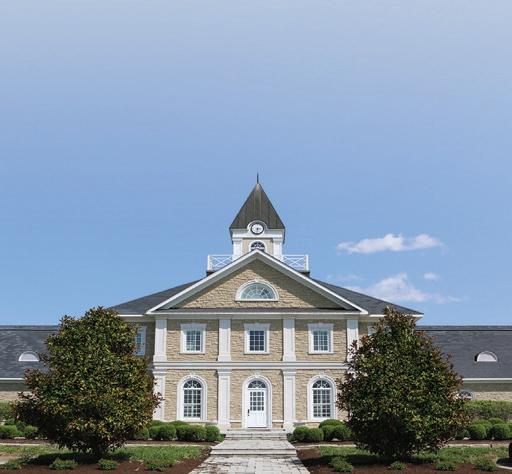
Adena Springs is a meticulously developed world-class, state-of-the art horse farm located in Bourbon County, KY and designed with both horses and horsemen in mind, ensuring top-tier care and functionality throughout.
The property built in 2007, features over 258 stalls, 24 homes, a stunning 6,250 sq ft office, a 14-stall stallion barn with breeding arena, meticulously landscaped grounds with ponds and fountains and much more – all situated on 2,245 pristine acres in the Bluegrass.
This is a rare opportunity for one to step into the highest level of the thoroughbred industry with fantastic facilities that are second to none!
For more information please scan the QR code below or contact Bill Justice on 859-255-3657


To further incorporate customization into a Thoroughbred’s work schedule, Vice President of Boarding and General Farm Manager Logan Payne explained that they follow a consistent six day work schedule that is specifically designed to bring out the full potential of each horse. Two days of machine walking is followed by two days of strictly handwalking in paddocks going about twenty minutes each in two different directions.
After those four days of muscle and bone building is completed, the yearlings will then move on to two days of ring walking where they will walk over rows of PVC pipes that are about five feet apart to get them into the habit of striding out for future inspections. “Some yearlings may be picked to swim depending on what they have going on. Maybe five out of one hundred will swim at a given time”, Payne adds. He is referring to the individualistic look into the close monitoring of the joints that are strained during the duration of yearling prep.
Wanting to restrict the straining of certain areas of yearlings during their transformation has become very common with the modern exercise schedules we have today within yearling preparation. Aqua treads and coldwater swims are becoming a lot more prominent in the industry with this task, given that a lot of farms and consignors use them.
However, maybe the biggest reason why yearling prep has changed over the years doesn’t quite start behind the gates of the farms. If we fast forward to the sale itself, we will quickly notice the rapid growth of precise radiograph technology. Behind the vast scrutiny of every bone and muscle in a horse’s leg at the sale, x- rays and ultrasounds have gotten into a horse’s profile more than they ever have before.
The best buyers and owners are vetting their horses to the absolute maximum, and every flaw or malfunction that these horses faced in their preparation for the sale will be brought into light.


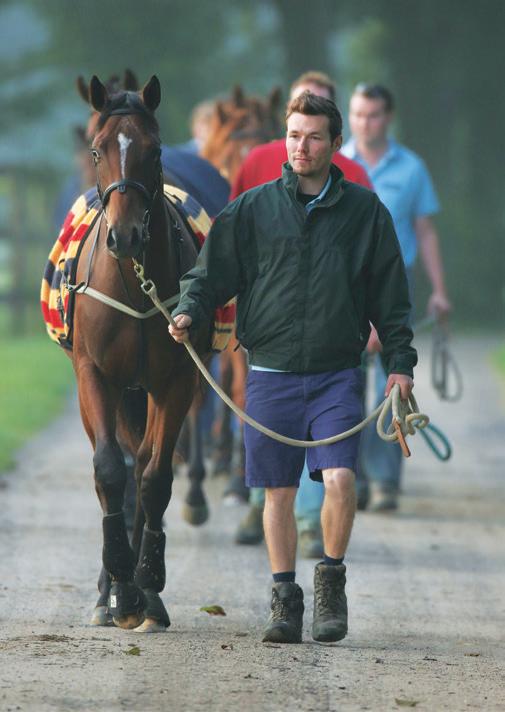
When raising horses to meet those standards, Taylor Made’s Director of New Business Development Frank Taylor states “We’re so focused on horses x-raying and scoping good, that it affects how we prep these horses.”
The minimal handling and veterinary technology of yearlings twenty to thirty years ago would simply allow such flaws to go undetected. Knowing this, the growing concern for sesamoiditis has such a strong influence on how yearlings are prepared that it dictates not only the method of preparation for each individual horse, but also the intensity of exercise they can undergo. “These images are getting more precise, and are showing more and more, which causes you to really watch how you’re prepping your horses”, Payne says.
Just like the precise vetting that dictates the value of a horse at auction, the preciseness in an exercise program for the individual horse and its needs is equally at high rise as well. With this information, I believe it is safe to say that prepping schedules are becoming as precise as the radiographs themselves.

Back over at Denali, Snellings has said “My thoughts would be with the use of your veterinarian, and the advances in x-ray. I think that we are all better equipped now to make good decisions on which horses fit into which program. And also, I think the surfaces that we have to work with now are so much better than what we had even 20 years ago.”
This shows how important it is to find the best schedule or program that fits each horse individually, so you’re not overdoing or falling short of unlocking a horse’s full potential before the hammer falls. In other words, you can’t work a yearling filly with a weak hind the same way you work a yearling colt with a strong shoulder to get the same result. Their bodies will clearly respond in different ways and will withstand and give out to ailments along the way. The recovery period to those ailments is when you start to run into problems.
The journey from farm to consignor showcases the everyday hard work and dedication that goes into knowing these horses individually to get them to their full potential before a sale. The sale reveals the finished product.

All and all, it seems the yearling market has both changed and balanced itself out when preparing the next generation of athletes for the industry’s greatest sales. The golden rule to follow, as Frank Taylor puts it, “Our goal is to raise athletic racehorses that are marketable as yearlings. So when we’re prepping a horse, we’re focused on getting the horse looking good and trying to get it very presentable so it will sell the most at the sale; but we’re also doing that with the idea that we do not want to do anything to detrimentally affect the horse’s racing career.”
Overall, yearling preparation has evolved from a more generalized approach to one that is highly individualized and responsive to every horse’s unique needs. Advances in conditioning programs, targeted exercise, nutrition, and veterinary technology have led to more customized care. Buyers come to the sale for one reason and one reason only; and that is to buy an athlete. In modern day, a deeper respect for the individual horse meets with a broader commitment to their future success on the track.









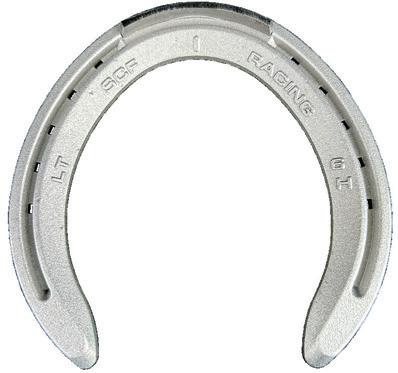









Despite an uncertain economy, the 2025 2-yearolds in training sale season wrapped up in June with an undeniable display of market power. Far from simply holding steady, Ocala Breeders’ Sales (OBS) and Fasig-Tipton broke numerous records across their major auctions. The market saw unprecedented top prices, and auction results demonstrated impressive leaps in gross revenue, average sale price, and median figures. The resilience in the marketplace sends a clear message: the demand for promising young talent is incredibly strong.
Buyer confidence drove significant year-over-year growth for both OBS and Fasig-Tipton. The 2-year-old sales, which ran from March through June, saw robust market activity. Out of 2,407 horses offered during the season, an impressive 1,955 (81%) changed hands, generating a total of $226,124,100 in gross sales. This performance marks a jump in gross receipts from 2024, when 2,137 out of 2,691 horses offered (79%) sold for $208,181,400.
The OBS March Sale made headlines with a record-setting renewal. A colt by Gun Runner, now named Brant, fetched an astounding $3 million. Donato Lanni, acting as agent for Zedan Racing, signed the ticket. Consigned by Eddie Woods—who retired after the OBS Spring Sale in April after 30 years as a staple at the 2-year-olds in training sales—Brant is out of the winning Liam’s Map mare Tynan, a half-sister to Gr.2 winner and multiple Gr.1-placed Pappacap and graded stakes winner Boppy O. Word was out on the precocious colt, who breezed a co- bullet eighth-mile in a blistering :09 3/5 at the under tack preview.
“The Gun Runner colt had a pedigree, and you don’t always see that kind of family and sire power at a 2-year-old sale,” Donato Lanni, a prominent bloodstock agent known for his sharp eye, said of the most expensive horse in OBS history. “He had everything, which is why we stretched a bit. He has a stallion’s pedigree. He could potentially do great things on the racetrack and be a stallion somewhere.”
Momentum continued at the OBS Spring Sale. The sale experienced year-over-year gains in gross sales and posted a record-breaking average price with nine horses bringing sevenfigure prices. OBS June closed out the lucrative sale season with a booming renewal. In the final hour of the two-day auction, a filly by Curlin consigned by Caliente Thoroughbreds established a record price for the June Sale, selling to Randy Miles on behalf of owner Gus King for $975,000.
The Fasig-Tipton Midlantic Sale in Maryland saw a Girvin filly take the top spot, selling for $1,100,000. She was purchased by Kerri Radcliffe/Alex Elliott, as agents for Memo Racing and Amo Racing. The filly is out of the Broken Vow mare Scarlet Dixie and was one of four horses to reach seven figures at the sale, marking a milestone. It was the 11th consecutive year the sale produced a seven-figure topper, and notably, the first time in its history that multiple juveniles sold for $1 million or more. Overall, the Midlantic Sale defied the odds, setting new sale records for gross revenue, average price, and median price. The achievement occurred despite facing challenges: severe weather forced the two-day sale to be consolidated into a single marathon session. Excessive rainfall even led to the cancellation of the breeze show, with the remaining horses galloping over the Timonium track for prospective buyers.
“It was a very vibrant 2-year-old market this year, especially at the top end,” said Lanni, who as agent acquired the top-priced colt and second-highest price horse of the Midlantic Sale—a $1,050,000 Violence colt consigned by Top Line Sales. “I think it has been about the same the last couple of years. The market


is strong. It was great to see that there were a lot of international buyers this year, especially at the Fasig-Tipton Sale. FasigTipton did a great job of soliciting outside buyers to come to that sale. There were more international buyers there than I have ever seen.”
Millions of dollars are exchanged at the 2-year-olds in training sales, creating a complex puzzle for buyers, consignors, and sales officials alike. The challenge lies in identifying prospects with the ideal blend of raw talent and potential. While speed is certainly a factor, it’s far from the only consideration for buyers. Some consignors are even opting to enter horses for gallop-only at breeze shows. This allows trainers to go a bit lighter on the horses earlier in their development, prioritizing long-term soundness over a fast workout time.
“The under tack previews are a part of the evaluation process,” said OBS President Tom Ventura. “They aren’t end-alls, but they certainly give the buyers another method in evaluating the horses. I think timed works are an important part of it. Whether they go in :09 4/5 or :10 or :21 flat, it’s the way they move that’s important. And the timed works are also for comparison. If the fastest time at a specific sale is :10 flat, then that’s the benchmark buyers will compare the other horses to.”
Despite the importance of timed workouts at 2-year-olds in training sales, the OBS March Sale introduced a new “Gallop Only” option this year, allowing sellers to designate horses in the catalog specifically for a gallop at the under tack preview rather than a full breeze. The new option proved successful. A bay colt by Curlin named I Did I Did (Hip 224), a half-brother to Gr.1 winner Sweet Loretta, sold for $300,000 to trainer Mike Maker. The colt’s dam is the stakes-placed Bluegrass Cat mare Ithinkisawapudycat. Hip 661 at the March Sale, a chestnut colt by Munnings out of the stakes-placed Tapit mare Ursula, sold to D.J. Stable LLC and Robert Cotran for $210,000. Both colts were consigned by Niall Brennan Stables, agent for Mt. Brilliant Farm.

“The Curlin colt we sold in the (OBS) March Sale for the ownerbreeder, he was a May foal,” Niall Brennan said. “He was a big colt, very well bred and they didn’t want him breezing in January. He just did a strong gallop, and he sold well. Mike Maker bought him; He’s a sharp judge. Here is a horse with a pedigree and a physical, so we were able to do that. But I think the trend this season anyway, people are willing to look at those horses. It’s encouraging.
“Obviously, some of the 2-year-olds in training sales were built on buying horses with physicals, not pedigree,” Brennan added. “They had to separate themselves on the racetrack and go out there and work fast to show their talent. That won’t change. The horses that have pedigrees, especially a nice filly, why beat them up? Just breeze them like normal in spring and you come see them do that. And if you love them, you don’t need to see them go :09 and change. It’s not going to be a dramatic change, but this season we have seen a light at the end of the tunnel. We don’t have to keep going faster, and faster, and faster. We can present these horses in their own natural rhythm and not push them too hard.”
When it comes to the highly competitive sales environment, buyers are faced with a wealth of information to consider. Breeze times, overall performance, physical integrity, and even the ability to overcome minor issues can all play a role in a buyer’s decision.
“Timed breezes, gallop outs, and the manner in which they do it and come out of it is one big compilation of information that buyers have to process,” Lanni said.
In July, Fasig-Tipton announced a significant shift for its 2026 Midlantic May 2-Year-Olds in Training Sale. The sale company will no longer officially clock breezes during the under tack show, instead aiming to showcase the natural athleticism of the horses to draw in more buyers. This will place the focus on a horse’s inherent talent rather than raw speed. Additionally, use of the riding crop will be restricted. Riders may carry a crop for safety purposes but they are not allowed to strike the horses during workouts.

“These changes reflect our commitment to improving our two-year-old sales process,” said Fasig-Tipton President Boyd Browning. “We believe buyer focus has skewed too heavily toward stopwatch-based evaluations. This approach is intended to restore balance–emphasizing how a horse moves and presents itself on the track.”
The traditional focus at 2-year-old sales has been on finding horses with speed. However, there is a growing sentiment within the industry that this emphasis might be shifting with some buyers now prioritizing long-term potential and soundness.
“I feel like it was getting to the point where everyone was automatically thinking that they need speed and a horse to run right now,” noted Ocala-based consignor David Scanlon, who sold a $1 million Nyquist colt at this year’s OBS March Sale. “People now seem to be spending more money and wanting more time to develop Classic-type horses. More horses sold this year that just galloped (at under tack previews) and I think that might be a trend that we see more of in the future. The perception of the 2-year-old sales might be changing for the better. It’s positive, and it’s very encouraging.”
The market for two-year-old Thoroughbreds can be a dynamic environment, often influenced by various factors, from economic trends to the perceived quality of the horses themselves. Despite challenges, prominent figures in the industry remain optimistic about the demand for top-tier prospects.
“We still have a good marketplace for the 2-year-olds,” said Brennan. “When you look back at OBS March and April and Fasig-Tipton Midlantic with the weather playing a factor there, we’re still seeing that what is perceived as quality sells very well. There is a market for these horses and people have shown they want to buy them, including racing partnerships. We still see foreign money at OBS in March and April and at Fasig-Tipton.

Where we are struggling is the middle market. Ultimately, there is a volume of horses that there are just no buyers for because we have too many and there aren’t the same number of people buying horses at that level. It’s just a fact. There is a smaller turnout for the 2-year-old sales compared to the yearling sales. If there has been a real positive this year, it was evidenced in March and April and especially in Maryland where we had no choice and a lot of horses did a strong two-minute lick, technically a gallop because it wasn’t timed against the clock.

LEFT: Both OBS and Fasig-Tipton broke numerous records across their major 2025 2-year-olds in training sale season auctions.
“We’ve been worried about this trend at the 2-year-old sales: How fast are they going to have to go? Will :09 flat be the next standard? Or :20 flat? That’s crazy. All of us—buyers and sellers, alike—can admit that is crazy,” Brennan continued. “We need to see the trend going more toward taking care of these young horses to continue their development so they can realize what they are bred to do. They are not supposed to be Quarter Horses. Speed is speed, and we know here in America some people want that and want to see them go fast. But there are a lot of good horses that don’t go in :10 flat that go on to win the Kentucky Derby and Kentucky Oaks.”
Buyers at the top end of the market are consistently seeking horses with the potential for major wins, rather than immediate speed.
“I think in all segments of the marketplace the emphasis continues to be on those horses that can win big races—whether it is a colt or a filly,” said Browning. “There are very few people shopping, particularly at the upper end, for a horse to win going five (furlongs). They are looking for Classic-type horses or horses that are going to win going a mile or further because that’s where the money is in terms of purses and long-term value. It’s a trend we’ve seen evidenced in racing and it’s evidenced at the 2-yearold sales and in the yearling sales. People are looking for the more two-turn type horses.”
While the landscape for 2-year-olds in training sales is constantly evolving, a slight shift in philosophy is influencing how some horses are evaluated. This is leading to a more nuanced approach to identifying future stars.
“I think it is changing a little bit,” Brennan said. “We have a lot of smart, educated people and very good agents that are looking for prospects at these sales. They are doing their homework, and they know what they are looking at. They are looking for something sound, something sustainable, and long term. They are not looking for a horse that is going to run five furlongs next week and that’s it. They are trying to buy horses for the long term. And I think that’s why they are willing to look at horses that two-minute lick down there and looked very good doing it.


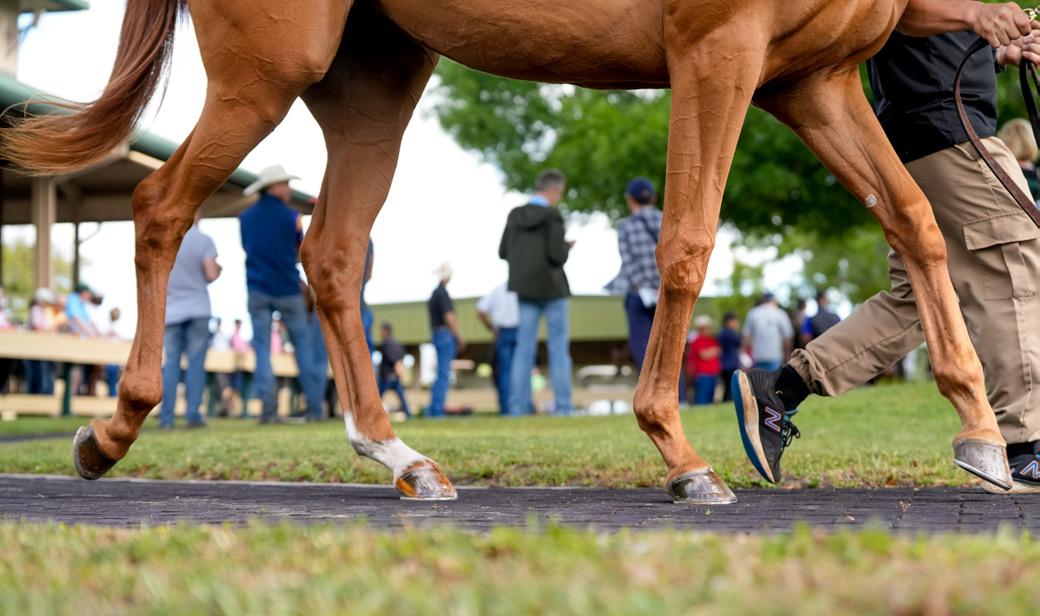
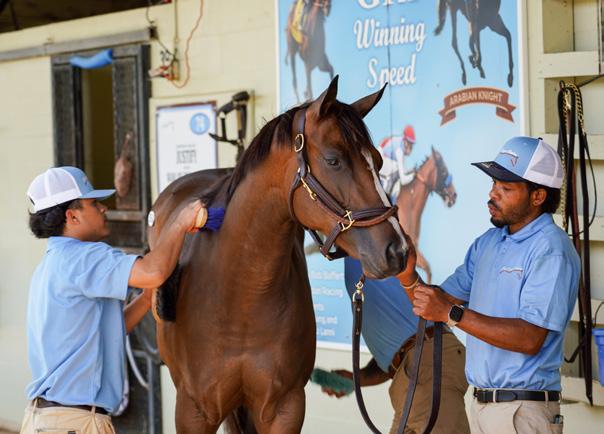
“You can tell a good mover just as easily as you can tell a bad mover,” Brennan added. “A bad mover is just a bad mover. He isn’t going to breeze good or gallop good. But if a horse has a nice pedigree, like a proven pedigree, and then you look at that horse and he is a great physical, now you can say, ‘I would buy this horse as a yearling in a heartbeat.’ There is a market for that type of horse. But there will always be trainers and buyers who want to try to buy the fastest horses in a sale. After all, it is American racing, and it’s about speed. There are many people in the business who can’t get out of their own minds, and the clock rules.”
The overall health of the marketplace is linked to the allure of the racetrack. High purses can significantly influence the willingness of individuals and partnerships to invest in young horses. Purse money, coupled with changing ownership models and new avenues for promotion, are contributing to a more vibrant and enticing marketplace.
“Purses ultimately are the reward and then the super successful horses are rewarded at the breeding end,” said Ventura. “When young horses are running for $100,000 maiden races, you don’t
have to compete at the very elite racetracks any longer to get high purses. That has been important in helping to keep things moving in the right direction. Despite the economic uncertainty and other outside influences going on, I think the result has been the people that are buying horses at the moderate level will have a chance to get a return by taking them to the races. High purse levels have not just helped the 2-year-old market but also the yearling sales, and all the way through. Hopefully, that trend continues, because purses are at the point now where stables can justify their participation. And we do have more participation due to partnerships and syndicates gaining more appeal.”
The continued vitality of 2-year-olds in training sales also hinges on the success of sale graduates at the racetrack. The proven success of sale graduates creates a powerful incentive for buyers to return and for new participants to enter the market.
“We also have to make sure we get repeat buyers based on the success that they have (with sale graduates), as well as attract new buyers,” Ventura shared. “Ultimately, 2-year-old sale graduates have been successful at the racetrack. No matter what statistics you use, 2-year-old sale graduates as a group have been more productive at the racetrack than any other group. We see it repeatedly, these horses competing at the highest levels. Moving forward, we always look for ways that we can improve the (sales) process, whether its rules regarding the use of the whip or other medication-type rules that we put in place. Those are always ongoing conversations, and I see that continuing with us tweaking things a little bit. But for the general model, I don’t see any major upheavals.”
Attracting and retaining buyers is vital for the health of any market. The 2-year-olds in training sales are no exception. While top-tier horses will always command high prices, there is a significant segment of potential buyers who operate with a more moderate budget. The challenge lies in making the sales more appealing to them. Brennan offers his perspective on how to broaden the buyer base, particularly by adjusting the expectations around timed workouts.
“The one thing that can be done is to attract owners to the 2-year-old marketplace,” Brennan related. “There are many people at the racetrack claiming horses. They would be ideal middle market buyers, but they need to feel like they have a shot.


Mile Tapeta Straight Track
Uphill Gallop Turf Course
Undulating Training Track
Gate Schooling
Individualized Programs


They can’t afford the horses that go in :09 3/5 or :09 4/5. They need to be able to come to a 2-year-old sale where they feel like they have a chance to buy horses in their price range. Maybe we need a way to level the playing field for them. If it’s not the clock, they might have a chance if there are a bunch of horses just doing a strong two-minute lick. And then they are in the same boat as everyone else. It will take time, but I have spoken to people this season and they have been very adamant about the fact that if we did that (more gallop only as opposed to timed breezes) that they would come back to the 2-year-old sales. If there are just a few horses galloping, that is not worth their time to attend a sale, but if there are 20 or 30 horses doing that, they will come to a sale.”
Fasig-Tipton has gone to great lengths to attract international buyers to its Midlantic 2-Year-Olds in Training Sale in May. Expanding the global reach is a strategic imperative for many in the industry, and targeted international outreach has proven particularly fruitful for Fasig-Tipton. Building relationships and understanding the specific needs of foreign markets can lead to significant increases in participation and investment. Browning highlights Fasig-Tipton’s dedicated efforts and the positive impact of international buyers, especially from the Middle East.

“There is no question that we have made significant investments in time, money, and more importantly in personnel in terms of being active in recruiting efforts abroad,” Browning said. “Anna Seitz has been our key person involved in recruiting and Michael Adolphson has been a representative that we have had in the Middle East for a few years. The timing of the (Midlantic) sale works very well with their racing calendar in the Middle East. The dirt (surface at Timonium) is also a positive factor as the majority of horses that race in the Middle East compete on a dirt surface. It’s a combination of all those efforts.
“There has been a significant increase in 2024 and again this year in 2025 in participation from buyers in that sector,” Browning added. “And they are having good results at home with horses they are buying in the United States. It suits their racing product very well. We hope those trends continue and increase in future years.”
The 2-year-old sale market is clearly in a period of evolution, adapting to economic shifts, changing buyer preferences, and new opportunities. From the introduction of “Gallop Only” options to strategic international recruitment and a renewed focus on longterm potential over immediate speed, the industry is finding innovative ways to attract and retain buyers. The sustained success of sale graduates on the racetrack, coupled with increasing purse levels at the racetrack, and accessible ownership models signals a hopeful outlook for this vital segment of the Thoroughbred industry.
Foal your mare in 2026, in Massachusetts, to make these benefits work for you:
• Benefit from a supplemental incentive of $10,000 – in addition to the purse of any unrestricted race in which a Massbred horse is entered at a licensed pari mutuel race meeting anywhere in the country authorized by the state racing commission.
• Benefit for Owner - 10%, Breeder - 25% & Developer - 20% (on racetrack purse only).
• Awards on the supplemental purse payout 1st through 6th place.


Rarely does such a unique, well-designed, constructed, and maintained world-class equestrian facility grace the international real estate market. Set on 510 preserved acres in one of Maryland’s largest agricultural preservation areas, RiverEdge Farm blends unique equestrian amenities with timeless elegance. At its heart is a 45,000 sq ft, 31-stall barn/indoor featuring old-world craftsmanship and exceptional design. Highlights include a 100’ x 200’ indoor arena, twin glass-enclosed observation areas, service bars, a commercial-grade kitchen, and a lofted second level with private offices, an exercise room, and lounge. The barn also includes six grooming/wash stalls, two tack rooms, a laundry room, and a panoramic three-season sitting room.
Complementing the equestrian center is a beautifully appointed 9,000 sq ft, 5 bedroom Georgian-style brick manor home and a luxurious guest home including an enclosed pavilion with a heated indoor pool.
An additional 15-stall center-aisle barn with six-horse Kraft Eurocizer, a fully equipped brick office building, and other operational structures support top-tier equestrian training. RiverEdge has been home to Olympic-level dressage and eventing horses for many years.
The property is co-listed by Patterson Schwartz Land & Farm Division & Monument Sotheby’s International Realty.






Cell: 302-379-6318
Toll Free: 888-909-FARM
Office: 410-885-1606
Email: ajohnprice100@gmail.com www.PattersonPriceLand.com
Broker Associate
Licensed in DE, MD, and PA
Cell: 302-545-5263
Office: 302-654-6500
Email: George.Hobbs@SothebysRealty.com

The late Ms. Josephine Abercrombie, a consummate horsewoman who founded Pin Oak Stud in 1952, left a tough act to follow when she passed peacefully in her home January 5th, 2022, just 10 days before her 96th birthday.
“Mrs. Abercrombie was an amazing lady and a great steward of the land, and most importantly, it was always the horse comes first,” said Clifford Barry, who’s been working at Pin Oak Stud for 35 years.
She would have smiled knowing that Dana and Jim Bernhard, who purchased Pin Oak Stud in November, 2022, and their son Ben, a rocket scientist turned horseman, have continued her good work, complementing their considerable success on the track with cuttingedge technology to prevent equine injuries, like the one that killed their first and best horse, Geaux Rocket Ride, as he was preparing for the 2023 Breeders’ Cup Classic. He was their first Thoroughbred, a birthday gift from Jim to Dana.
Simply put, the Bernhards, like Abercrombie, do the right thing. “That’s where it all starts,” Ben said. “Everything we do, we put the horse first, and my parents have driven that point home.” His mother said, “We are passionate about doing a good job for the horses. They can’t speak for themselves.”
Barry has witnessed the Bernhards’ ongoing commitment: “It’s been amazing to watch Jim and Dana be like-minded as Mrs. Abercrombie. I mean it really has been heartwarming to watch. Anytime you go through a major transition like this, you worry what the next entity will involve. But they’ve come in, and we got a facelift to the farm and added new property and new buildings and really have got the horses’ health and welfare at heart for sure.”
Abercrombie was an incredible owner and breeder. Among her nearly 100 stakes winners were her home-bred Eclipse Champions Laugh as well as Confessional, Peaks and Valleys and Broken Vow. She was The National Breeder of the Year, in 1995 and the winner of the Hardboot Award from the Kentucky Thoroughbred Owners and Breeders Association and the William T. Young Humanitarian Award. In 2018, Abercrombie was the Honor Guest of the Thoroughbred Club of America in appreciation for her “enduring sportsmanship, acumen and vision, and her devotion to the loftiest principles established by earlier leaders on the Turf.”
Like Abercrombie, Dana grew up with horses: “I grew up in Louisiana. I was given my first horse, a Tennessee Walker, when I was eight years old, and I’ve owned a horse ever since. I began riding that day. She was a trail horse for me. I was given my next horse for my 10th birthday, Dixie. I had her until I was 29. My love was horses, not just racehorses.”
Dana worked as a corporate attorney and marketing director. She met Jim, the founder and partner of Bernhard Capital Partners, through work. Jim’s company, based in Baton Rouge, now manages about seven billion dollars buying and investing in companies, and has some 30,000 employees.
“I was a lawyer and our law firm handled Jim’s corporate law,” Dana said. “He was a client. When we decided to start dating, we had an office rule against dating co-workers. I said, ‘How about clients?’ The senior partner offered me a list. We got married some six months later.”
They married in 1993 and Jim became an avid horseman. Asked why he loved it, he said, “Because Dana loves it.” They have purchased and maintained a dozen Friesians, a breed originated in the north Netherlands which nearly went extinct more than once. They ride their horses at Pin Oak Stud in Kentucky and Pin Oak Stud South in Baton Rouge. “When we got our first Friesians some 13 years ago, there were less than 75 in the United States,” Dana said. “Their personality reminds me of our two labrapoodles. They are just big puppy dogs.”
In June, 2021, Jim gave Dana a birthday gift, a trip to Lexington to buy a Thoroughbred yearling at the Fasig-Tipton July Sale. They wound up with three yearlings. The first one was Geaux Rocket Ride, a son of Candy Ride out of the Uncle Mo mare Beyond Grace. He cost $350,000 and was given to Hall of Fame trainer Richard Mandella.
Geaux Rocket Ride won a maiden race by 5¾ lengths, then finished second by 2½ lengths to Practical Move in the Gr.2 San Felipe Stakes. Another victory by a length and three-quarters in the $100,000 Affirmed Stakes convinced his connections to up the ante. Sent off at 12-1 in the Gr.1 Haskell at Monmouth Park, Geaux

Rocket Ride went head-to-head with the even-money favorite, Arabian Knight, put him away, then turned back a rally by Kentucky Derby winner Mage, winning by a length and three-quarters. In his final start before the Breeders’ Cup Classic at Santa Anita, Geaux Rocket Ride was second by a neck to Arabian Knight in the Gr.1 Pacific Classic. His three victories and two seconds in five starts had produced $980,200 in earnings. He was a legitimate contender for the Classic.
“In the Haskell, we were thrilled,” Dana said. “Rocket was such a feisty horse on one hand, feisty with his feed bucket, but in the barn and the paddock, he was so kind and loving. He loved his bath. He played with the water hose. He was quite a character. We just loved him. He was our first racehorse. We still love him to death.”

One week before the Breeders’ Cup, with Dana and Jim watching his workout live on TV, Geaux Rocket Ride suffered a horrific injury in his front leg, which was described by Breeders’ Cup officials as “an open condylar fracture with intersesamoid ligament damage.”
Dana said, “We were at our home in Pebble Beach and about to fly down to LA. We watched him live.” Jim said, “We saw it live. We didn’t know the extent of it until we drove down there. We couldn’t save him. His leg was too far gone.”
He was euthanized the following Wednesday. “It was a typical roller coaster ride,” Mandella said. “We had the greatest time with him, but also had one of the worst days of my life.”
His respect for the Bernhards is immense: “It’s a wonderful family, I can’t say enough good things about them. They want to do everything right by the horse.”
Ben, who had spent a lot of time hanging out with Mandella at his barn, was deeply affected, so much that he decided to leave Space X in Los Angeles and become a vice president of Pin Oak Stud and start his new company of developing equine sensors, Stable Analytics, with technology similar to the ones he had used at Space X: “Geaux Rocket Ride was training at Santa Anita, and I used to hang out with Richard Mandella, probably the biggest reason I’m into horse racing. Learn from him. Watch Geaux Rocket Ride train. I just got so into it. I decided to make the move.”
Dana said, “It was a wonderful thing. He is very passionate about preventing this type of accident in the future.”
Jim said simply: “He’s smart.”
Ben said of his career change: “It’s a lot of things that are different obviously, but there are surprising similarities. I talked to my friends back at Space X. They said, ‘There’s nothing like the rush you get watching a rocket launch.’ I said, ‘There’s something similar, watching your horse win a race.
“I came into this trying to make it as much of a math problem as I can. I know math and engineering. I think there’s an opportunity to look at it from that perspective. Geaux Rocket

Ride had the best horseman, the best jockey, the Breeders’ Cup veterinary staff and somehow he still gets injured. There’s got to be a way to detect things.”
Ben developed equine sensors, which all the 150 to 170 Thoroughbreds wear at Pin Oak Stud: “They’re practically air-space sensors which began in the aerospace industry. We see gait changes and data. I’ve never really been a horse person. Richard Mandella changed that.”
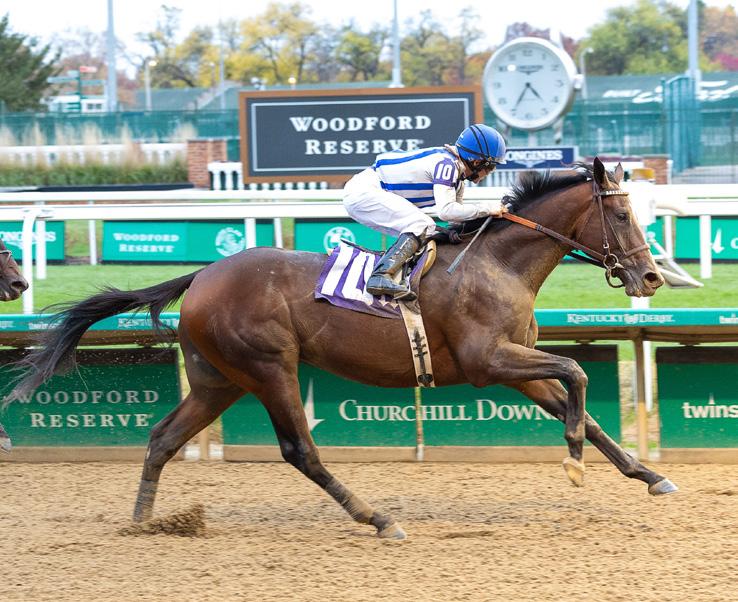
Mandella said of Ben, “I’m sure he makes his parents proud. He’s just a class person, a gentleman, and maybe genius-smart. Yet he’s just the most normal young guy you could ever meet, just a pleasure to be around.”
At the Keeneland 2022 September Yearling Sale, the Bernhards bought Parchment Party, a son of Constitution out of Life Well Lived by Tiznow bred by Bobby Flay for $450,000. Ben’s sensors caught a potential problem. “We found a small abscess that was growing,” Jim said. “We were able to take care of that long before it became a major problem.”
Parchment Party, who is trained by Hall of Famer Bill Mott, won his first two starts. On June 6th, 2025, at Saratoga, he captured the Belmont Gold Cup when it was switched from turf to dirt, by 8½ lengths. In doing so, he clinched a berth in the starting gate for the Melbourne Cup, the race that stops a nation.
“He’s the first Kentucky-bred to make the Melbourne Cup,” Jim said. “Australia? It’s just a little island down south from here. It’ll be fun.”
LEFT: Parchment Party won his first two starts, both at Churchill Downs, his next win was the 2025 Belmont Gold Cup at Saratoga Race Course.






SPORT QUEENS FRONT & HIND
EC QUEENS FRONT & HIND
EC QUEENS WEDGE FRONT & HIND
RX FRONT & HIND
SPORT XLT HIND
SPORT XLT WEDGE HIND
SPORT LT HIND
EC XLT HIND
EC XLT WEDGE HIND
EC LT HIND
RX XLT HIND
























Nineteen years removed from the triumph and tragedy of their Kentucky Derby winner Barbaro, Roy and Gretchen Jackson are still winning major stakes on both sides of the Atlantic Ocean. Their outstanding turf filly She Feels Pretty won her fourth consecutive graded stakes, taking the Gr.1 New York Stakes at Saratoga June 6th. “We’re still kicking,” Jackson laughed. “At our age, 88, we’re sure enjoying it. We’re just lucky to have this horse.”
Their horses have been lucky to be owned by the Jacksons.
“I was a big fan of theirs since Barbaro,” She Feels Pretty’s trainer Cherie DeVaux said. “You see them go through the highs and lows and they handled that with such grace. It’s really special to have a relationship with them.”
There are few breeders and owners who have raced so many top horses in North America and Europe, including the unbelievable feat of Barbaro winning the Gr.1 Kentucky Derby and George Washington winning the Gp.1 2000 Guineas on the same afternoon, May 6th, 2006. “They’ve both been wonderful experiences,” Jackson said. “We’ve been pretty lucky in the whole situation. You don’t know if they’re going to stay healthy. It’s such a gamble. We just sort of plodded along through the years just trying to have some fun.”
They sure know how to plod along. She Feels Pretty has already given the Jacksons their 14th season with more than one million dollars in earnings and their 18th over $900,000. Their horses have won 495 races from 2,511 starts with earnings topping $32.4 million. And, of course, they were the Eclipse Award Outstanding Owners of 2006.
She Feels Pretty and John Velazquez win the 2025 New York Stakes at Saratoga.
Being able to share this success together cannot be underemphasized. “It’s been great,” Jackson said. “She’s the one. She was involved at a young age riding.”
They grew up just 10 miles apart in Pennsylvania. Gretchen was a foxhunter, a pastime of Roy’s mother, who also dabbled in racehorses.
Roy spent six years as a stockbroker before following his passion for baseball, owning a couple minor league teams and cofounding Convest, a management firm for professional athletes. He sold his share in the company to concentrate on horse racing.
By then, Lael Farm was up and running successfully. The Jacksons purchased the 190-acre property in Chester County, Pennsylvania, in 1978 and named it Lael, the Gaelic word for loyalty.
They backed up their loyalty by taking care of all their horses when they were done racing. For years, Barbaro’s dam, 25-yearold La Ville Rouge, who earned more than $250,000 with six victories from 25 starts for Hall of Fame trainer Phil Johnson, shared her paddock with Superstar Leo, the first horse the Jacksons purchased in Europe, and $400,000-plus graded stakes winner Belle Cherie, also trained by Johnson.
In five consecutive starts, Superstar Leo won the Gp.3 Norfolk Stakes at Royal Ascot, a restricted race for sales graduates, finished second in the Gp.1 Phoenix, won the Gp.2 Flying Childers and finished second in the Gp.1 Prix de ’Abbaye de Longchamp. She finished her career with five victories and four seconds from 13 starts, earning $284,001.
From 15 foals, she produced 11 winners, including Enticing, a dual Gp.3 winner and the dam of three-time Gp.1 Prix de la Forest winner and $1.2 million earner One Master, who had seven victories from 23 starts.

After Superstar Leo died on Lael Farm at the age of 26 on June 26th, 2024, Jackson said, “We were very lucky to purchase her after my wife Gretchen happened to see her run. We brought her over from England after she was through having foals to live out her life at our place.”
That’s a destination Barbaro never reached.

Barbaro was brilliantly trained and managed by legendary equestrian Michael Matz, a six-time U.S. national champion who was given the honor of carrying the U.S. flag at the 1996 Olympics Closing Ceremony. Seven years earlier, on United Airlines Flight 232, he saved three siblings traveling alone and went back to rescue an 11-month-old girl after the plane crashed. Onehundred eighty four people survived the crash; 112 did not. The
three siblings remained in touch with Matz and hooked up with him before he saddled undefeated Barbaro in the 2006 Kentucky Derby. In a domination seldom seen in the Run for the Roses, Barbaro won effortlessly by 6 ½ lengths under perfect handling by Edgar Prado. That made Barbaro six-for-six, three-for-three on both turf and dirt, with earnings topping $2.3 million.
He didn’t survive the Preakness. After breaking open the starting gate and being reloaded, Barbaro suffered a catastrophic fractured right leg in the first eighth of a mile.
Over the next eight months, fans and non-fans followed his battle to survive under the care of Dr. Dean Richardson at the University of Pennsylvania’s New Bolton Center. After finally getting well enough to graze outside his barn, he suffered the crippling, painful hoof disease laminitis, the same disease that killed Secretariat in 1989. Barbaro was humanely euthanized. Gretchen said at a press conference. “Grief is the price we all pay for love.”
It’s nearly 20 years later. “Isn’t that unbelievable?” Roy Jackson said. “It was like a real roller coaster. Dean Richardson would call every morning. So many people followed the whole situation. We couldn’t believe the bins of cards we got from kids.”
Now, the Jacksons have another popular horse, She Feels Pretty, who has already won four Gr.1 stakes, missing two more by a halflength and three-quarters of a length. Overall, she’s 7-for-11 with two second and two thirds. “She’s amazing,” DeVaux said.
And she has a pal, a black and white goat that dutifully follows her around, even loading into a trailer. His name is Mickey. “Mickey has been to Woodbine, California, Keeneland and Saratoga,” Jackson said. “Mickey has done the job. Mickey’s really got to get some of the credit for the whole thing.”
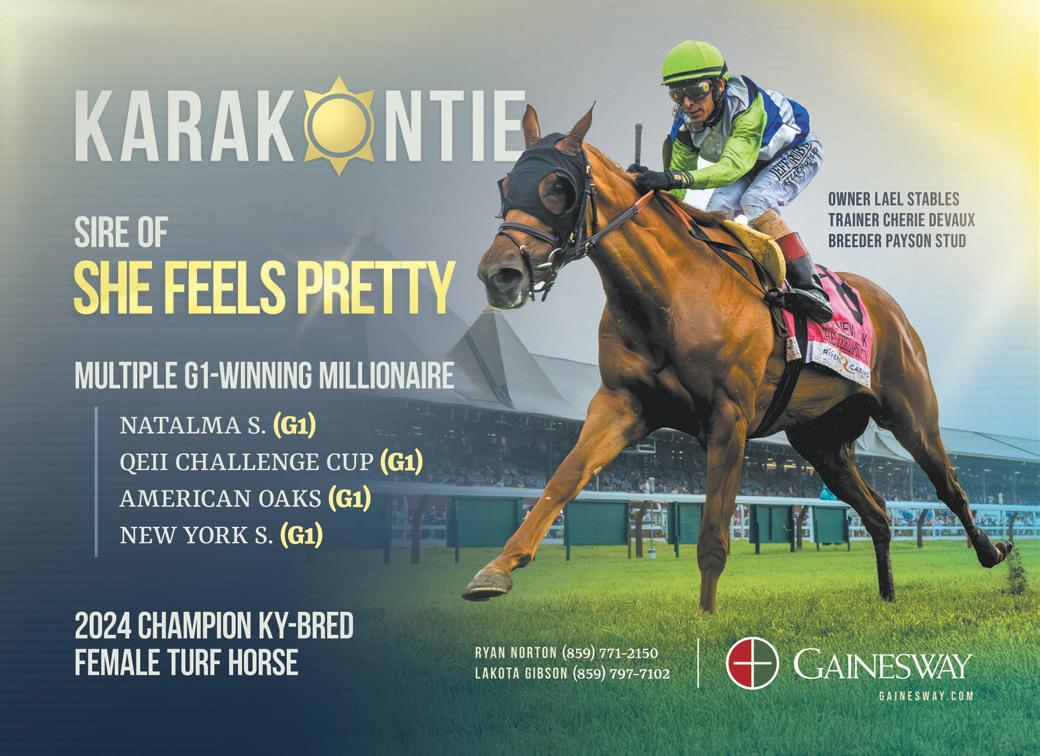

An owner’s thrill winning a graded stakes is even greater when that horse is a home-bred. And if there’s a special bond between horse and owner, so much the better.
Gabriel “Spider” Duignan, who usually doesn’t keep the fillies and colts he breeds, knows that feeling. When Echo Sound, a daughter by Echo Town out of Eagle Sound by Fusaichi Pegasus, who was co-bred by Vision TBs and Bruce and Patricia Pieratt, captured the Gr.3 Miss Preakness Stakes at Pimlico May 16th, Duignan and his wife Aisling had completed a personal vow.
“What makes her special was her mother was very special to us and very good to us and a great producer,” Duignan said. “I think she was the first mare we bought together. She was getting older, and she hemorrhaged and died shortly after birth, a couple hours after giving birth. That’s never nice to watch, but it happens. That was her first filly. She’s a home-bred. From that standpoint, it makes her a little special. We vowed that we’d keep Echo Sound.”
They’ve never regretted that decision.
Echo Sound was born on the Duignan’s 300-acre Springhouse Farm near Lexington, not far from Ashford Stud, where Aisling works as the Director of Bloodstock. They own half of the 100 Thoroughbreds living there. The other half belongs to their clients.
The Duignans purchased Eagle Sound for $70,000. Before Echo Sound, she had produced eight winners. She was 19 when she foaled Echo Sound.
Echo Sound has won five of her six starts and made over $450,000 under the care of trainer Rusty Arnold. Her last race was a 4¼ length romp at Saratoga in the Gr.3 Victory Ride Stakes
at Saratoga July 3rd. That was sweet for Arnold, who trained Victory Ride: “It’s a really good thing to run in a race named after one of your horses. Not many people get to do that. So it’s fun.” Duignan said simply, “Today was her best race.”
Echo Sound is the first horse Arnold has trained for Duignan: “I have known Spider for a long time through the sales and being around Keeneland. I hadn’t trained for Spider. About a year ago, when the filly went to Florida to be broken, he approached me and said, ‘Hey, I’ve got a filly we’re going to put in training and I’d like to give you this filly.’ I said, ‘I’d love to have her.’”
He’s been smiling ever since: “As owners, they’re the greatest. He said, ‘My deal is I send you the horse and you drive the car and just tell us how she’s doing and where we want to go and what you want to, and we’re on board.’ He said this was his mare’s last foal and he wanted to replace the mare with her.
“They’re horse people, he and his wife. They’re wonderful people.”
They have made a substantial impact in Thoroughbred racing ever since Duignan emigrated from Ireland to America with a plan he never followed four decades ago.
“I’ve been lucky. I’ve definitely been lucky,” Duignan said. “I was just one of those kids born with a love of horses. I started out with ponies. I realized I couldn’t make it as a rider.”
He took a job at Airlie Stud, succeeding a worker nicknamed Spider. When his boss at Airlie struggled to pronounce Duignan’s name, he gave him the same nickname. It’s stuck for the rest of his life.
At Airlie, Duignan met the veterinarian, John Hughes, who took a personal interest in him and arranged a job for him across the Atlantic: “John Hughes sent me to America to Bill O’Neill at Circle O Farm. I’ll be forever indebted to John Hughes. That was my first trip to America. At 21, you have a different view. You’re looking to explore. My plan was to do a year here in America and a year in Australia and then back home. But I loved Kentucky. I never went to Australia.”


In America, Duignan hooked up with another Irishman, Pat Costello, who had preceded him to America by six months. Costello also worked at Circle O and they became close friends and partners, originally participating in a partnership called The Lads. In 2001, they co-founded Paramount Sales. “Pat and I started Paramount Sales and that was great,” Duignan said. “We’ve never had any differences. I’ve always been lucky to have great partners.”
Duignan, who also hooked up with David Garvin at Ironwood Farm and Dr. Tony Lyons of Castleton Farm, credits both of them for his success.
In the spring of 2022, the Duignans were honored to return to Ireland to accept the Wild Geese Award from the Irish Thoroughbred Breeders’ Association, made to “compatriots who fly the tricolour in exemplary fashion on foreign fields.” Duignan said, “That was a nice award from my peers. It meant a lot to me.”
Horses still do: “I enjoy getting a good horse and selling a good horse. I still love the whole process.”


In racehorses, exercise-associated sudden death – or EASD – is a very rare event but it can happen and this article is written to highlight a need for better understanding of why it happens as well as motivating vets, researchers and horsemen to do more to prevent it.

In June 2024, Woodbine Racecourse, Toronto hosted the International Horseracing Federation’s (IFHA) Global Summit on Equine Safety and Technology where EASD was one of two major workshop topics. This international event was sponsored by Cornell University’s Harry M. Zweig Memorial Fund for Equine Research, The Hong Kong Jockey Club Equine Welfare Research Foundation, and Woodbine Entertainment Group. Specialist veterinary clinicians, pathologists and researchers spent two days sharing knowledge and ideas and debating how tangible improvements to equine safety and welfare in racing could be made towards reducing the prevalence of both EASD incidents and severe musculoskeletal conditions.
The term EASD is used to describe a fatal collapse in a previously healthy horse either during or shortly after exercise. Currently, across the world, different time-windows are used by regulators which makes quantification of the problem challenging. A benchmark definition is needed so that the occurrence rates can be audited and the EASD workshop team advised that an international definition is adopted to define EASD as within approximately one hour after exercise. Figures from the BHA show that in the UK, the 2024 EASD incident rate was 0.04% or 4 horses per 10,000 starts – which with just under 90,000 runners translates to 36 EASD losses for the year which is why the triple Cheltenham deaths were so extraordinary. The UK’s rate is comparable with other nations such as Australia and a little lower than the USA although the different definitions used in different racing jurisdictions make direct comparisons challenging.
The most authoritative international study looking at causes of EASD was performed with the Horserace Betting Levy Board supported by a group in the University of Edinburgh’s Royal Dick School of Veterinary Studies. This report showed that determination of cause of death is significantly impacted by


individual pathologist’s interpretation of findings, however, in broad terms about a quarter of cases of EASD have a clear and definitive diagnosis of cardiopulmonary failure and a further 10-15% have necropsy findings which are strongly suspicious of cardiac or pulmonary failure; around 10% of EASD cases are due to hemorrhagic shock brought on by rupture of a major blood vessel which is most commonly within the abdomen, while unfortunately around 20% of cases are unexplained despite detailed examination. A range of other rare conditions including brain and spinal problems, often relating to trauma, account for the remainder.
Within the cardiopulmonary failure category, it is generally accepted that the majority relate to cardiac arrest. This means that the cardiac rhythm is disrupted but, in fact it is actually very difficult to prove that a cardiac rhythm disturbance has been the trigger mechanism of death during a post-mortem examination. In the June 2024 IFHA summit, a significant amount of the workshop was dedicated to discussing current knowledge of cardiac rhythm disturbances, why they occur and how they might be detected in the future.
Cardiac arrest can be likened to a perfect storm where multiple adverse factors combine with devastating impact. Unlike catastrophic bone fractures or tendon injuries, cardiac arrest does not necessarily relate to an accumulating pathway of builtup microdamage and because of this, it is very difficult to predict cardiac arrest might occur.

ABOVE: This horse had an episode of distress on the racetrack when vets detected that the cardiac rhythm was irregular. Looking back over its training record, episodes were noted when the heart rate was higher than usual and examination of the ECG traces showed that there were cardiac rhythm disturbances. In this example, the lower panel shows a plot of heart rate over time: the spikes in the heart rate indicate individual premature depolarizations which is confirmed by examining the ECG above which shows a premature complex followed by a pause.


ABOVE: This horse has had episodes of atrial fibrillation previously: on the day this ECG was recorded, his rider and trainer noted that he was not working well. The heart rate during the training session was excessively high, approaching 250 beats per minute. The lower panel shows a plot of heart rate over time and this shows first the heart rate takes a sudden jump upwards (red arrow) and becomes fuzzy, indicating there the intervals between beats are varying. As the heart rate slows down this variation from beat to beat becomes more obvious and the ECG above confirms the rhythm is very irregular. The rhythm disturbance self-corrects at a heart rate just over 150 beats per minute (green arrow) and thereafter the plot is smooth indicating a regular heart rate. The case shows that without the training wearable, the diagnosis could not have been made because well before the horse returns to his stable, the cardiac rhythm is entirely normal again.
For a cardiac rhythm disturbance (aka an arrhythmia) to develop three elements are required: a substrate, triggers and, in some cases, one or more modulators. A substrate refers to the structure of the heart, this can be an area of scar tissue but the heart structure does not necessarily need to be pathological and the changes in muscle content which arise as a result of athletic training may also be a substrate.
A trigger reflects a change in the cellular and tissue environment such as alteration in concentrations of different electrolytes or development of low oxygen concentrations in the tissues yet changes in electrolytes and lowering oxygen concentrations occur every time a horse gallops. Modulators are an electrophysiological characteristic of the heart which might be a permanent feature of an individual’s cell make-up or more often might be a transient state such as a variation in the nervous system brought on by excitement, stress or perhaps pain.
The key point is all these independent factors have to combine to precipitate a cardiac arrest – indeed a horse might go through its life uneventfully despite the presence of a particular substrate
or it may experience these triggers on a daily basis and come to no harm. It is the coalescing of multiple factors at a given moment that precipitates the rhythm disturbance that leads to cardiac arrest.
Arguably the biggest challenge we currently face in this arena is lack of knowledge of what is normal in the exercising horse. There is very little understanding of structural and electrical remodelling of the equine heart in response to exercise. We do know that the heart, just like any other muscle, will increase in size in response to training and we also know that in horses competing over longer distances such as steeplechasers, a big heart confers an athletic advantage. Exercise training can also lead to scar-tissue formation but in both human and equine athletes the importance of this pathology is uncertain. There is some evidence that fit horses also have altered cardiac electrical characteristics but again, knowledge in this field is very sparse.
Electrical activity in the heart muscle cells is controlled by ion channels – these are proteins that are sited within the cell

ABOVE: Vets currently rely on resting and exercising electrocardiograms (ECG’s) to identify horses with arrhythmias.
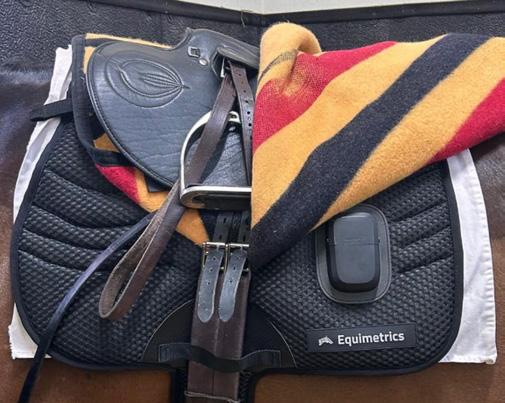
ABOVE: Increasingly more trainers have been using wearable devices during routine training to refine their training programmes.
membranes which effectively act as gates opening and closing to allow electrolytes such as sodium, potassium and calcium to move in and out of the cell and in doing so the electrolytes carry the electrical current.
Channelopathies – or abnormalities in these ion channels - have an important role in the development of rhythm disturbances but right now, research on equine ion channels has been limited… but that is changing rapidly. Researchers in the UK, Copenhagen and various US universities are working to understand equine channels and the genetic and acquired factors that determine how they function. As knowledge accumulates it may be possible to include tests for the molecular make -up of an affected individual in post-mortem exams – the so-called “molecular autopsy” which is improving diagnosis rates in human cardiac arrest suffers.
So far equine studies have not found conclusive evidence of genetic mutations associated with EASD. But there is evidence for heritability in the Thoroughbred: observations from Australia which have shown some stallions’ and at least one mare’s progeny have higher rates of EASD associations suggesting that it is likely that there are genetic elements at play in EASD. One of the key recommendations of the IFHA’s EASD workshop was that tissues from both horses impacted by EASD and those dying of other causes should be banked and shared amongst researchers to underpin and promote research studies in this area.
Currently vets rely on resting and exercising electrocardiograms (ECG’s) to identify horses with arrhythmias. However, there are a number of limitations to using ECG as a screening and diagnostic tool:
• ECGs can be technically difficult to perform during exercise as they are affected by motion artefact; leading to reduced quality of the trace.
• ECGs currently must be manually interpreted, which is time consuming and leads to significant intra- and inter-observer variability.
• There are no universal guidelines on how to perform the ECG; i.e. exactly where to place the electrodes, which affects the trace produced.
There is no consensus on interpretation of the results of an ECG examination in terms of the clinical significance of any abnormalities detected and whether the clinical presentation impacts criteria for interpretation. Indeed, we need to understand more about what is ‘normal’, before we can identify horses with an ‘abnormal’ trace.
Over recent years, increasingly racehorse trainers have been using wearable devices during routine training. Generally, the trainer’s motivation is to collect data on speed and fitness variables in their horses to refine their training programmes but several of these devices also have the capacity to include an ECG trace. The ECG can then be accessed if the horse has a problem during a training session and, usefully, the horse’s past record can also often be interrogated. The large numbers of recordings that are currently being made represents an untapped resource for collecting ECG information from large numbers of horses to better understand cardiac responses during exercise in both healthy and unhealthy individuals.

BELOW: There is an urgent need to develop AI systems which can screen training ECGs to identify those that warrant further attention.



It has been known for some time that healthy horses frequently have mild rhythm irregularities – generally described as premature complexes or premature depolarizations – these minor fluctuations in rhythm occur at all phases of exercise and particularly as their heart rate is slowing rapidly at the end of a gallop. But the dividing line between what is normal variation and what is clinically concerning is not clear-cut. We do not know exactly how much beat-to-beat variation can be classed as normal versus a sign of significant arrhythmia and we have little understanding of the relationship between premature depolarizations and other factors such as stress, exercise intensity, medical interventions and adverse clinical events.
As a result, veterinary clinicians are looking forward to the ongoing expansion of wearables as an exciting new window into equine cardiac function. Yet, the scale of the unexplored data collection currently going on in training brings with it a challenge – with so many ECG traces being rapidly collected, how can we address the mammoth task of actually looking at them? Artificial intelligence (AI) is revolutionizing many aspects of modern life, including medical diagnosis. There is an urgent need to develop AI systems which can screen training ECGs to identify those that warrant further attention. And, although a large number of wearable devices are available on the commercial market, these products often lack validation which is needed before we can use the data they collect to make clinical decisions on individual animals and use the data as a research resource.

Racetrack arrhythmia/collapse are, in reality, low probability but high impact events which can be difficult to manage due to their traumatic nature and the fact that they are often played out in the public eye. This is compounded by the availability of medical equipment and limited treatment options that may be futile.
However, when these events do unfortunately occur, they represent a golden opportunity to collect diagnostic information and biological samples which could be used to prevent future EASD events in other horses in the future. The combination of an ECG history, a video of the horse as it suffers the event, information from necropsy if the horse dies, and tissue banking offers valuable research insights.
The nearest parallel event from human sport is the cardiac arrests which are occasionally seen in footballers. Through the effort of football’s regulators, today pitch-side emergency medical facilities are excellent and large numbers of trained staff are in attendance, all leading to the best possible outcomes for sportsmen when medical problems arise. When looking to perform cardiopulmonary resuscitation and treatment attempts in the collapsed horse, the animals’ size is a major challenge; human defibrillators simply do not work in large animals.
We need more information on emergency medications that can be used in the presence of arrhythmias of unknown origin. These drugs need to be quick to administer, available and suitable to be carried by a racecourse vet, safe, effective and affordable. The IFHA’s EASD group identified that in pressurized situations, predetermined protocol approaches to both emergency treatment and necropsy procedures are invaluable and the group is working to develop these protocols for dissemination across racing jurisdictions.
As EASD is such a rare event, it is impossible to believe that the risk of EASD can ever be removed entirely, but given the recent technological development in both veterinary science and wearables for training, there is reason to be optimistic that in the coming years, we will at last be able to improve diagnosis rates, identify some of the contributing risk factors and even potentially provide more effective emergency treatment options for these unusual but tragic episodes in our horses.

Equimetrics - providing smart equine monitoring solutions for the sports performance and veterinary industries.
S-PRO – Sports Performance
• Records heart rate, movement, speed and stride data.
• Tracks post-exercise recovery and fitness levels.
• Provides training analysis, comparisons, and shareable reports via the app.
V-PRO – Clinical & Remote Monitoring
• Continuous remote monitoring of patients both in the clinic and off site.
• Easy ECG capture at rest and during exercise.
• Real-time alerts and cloud-based data access through the app.
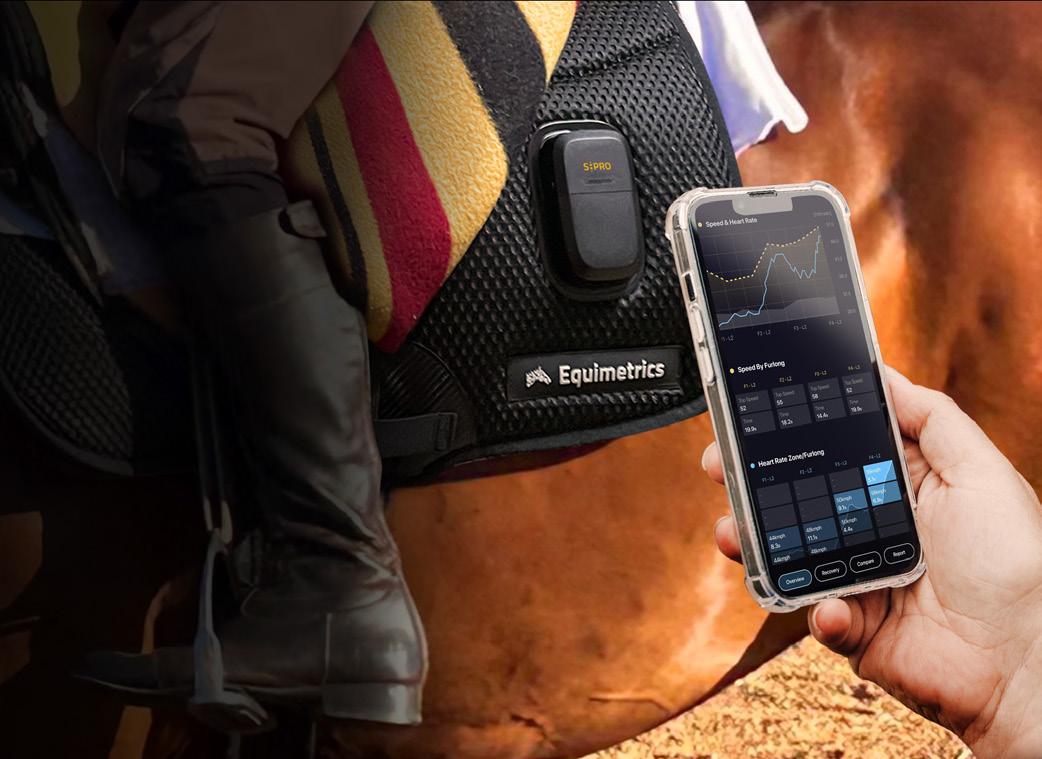
Order now or contact us for more information: info@equimetrics.ie
Order now or contact us for more information: info@equimetrics.ie

Medical care so advanced it almost makes you wish you were a horse.
We offer every type of medical care your four-legged athlete could ever need. With board-certified specialists in all fields we provide everything from upper airway, arthroscopic and laparoscopic surgeries, to internal medicine, complex fracture fixation and advanced diagnostic imaging, including bone scans, CT scans and MRIs – all in one place. It’s enough to make a human jealous.
800.724.5358
40 Frontage Road Ringoes, NJ 08551 www.midatlanticequine.com
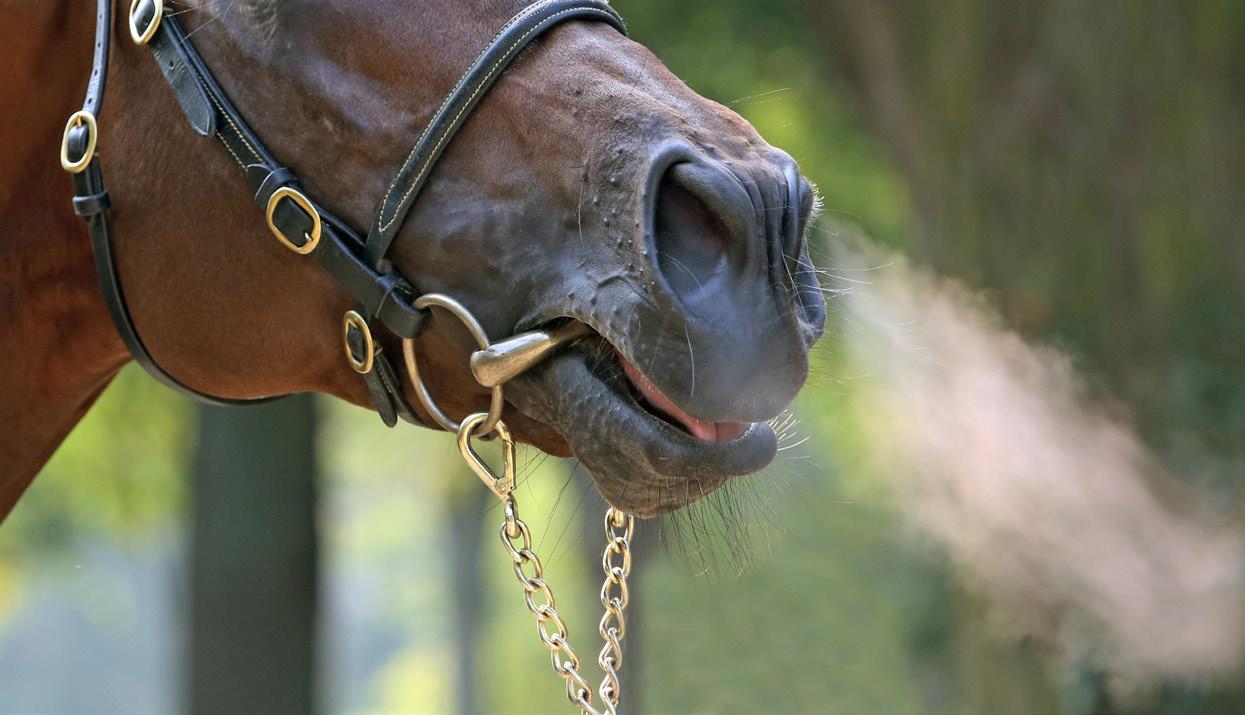



TBeaufort Cottage Educational Trust hosted the annual Gerald Leigh Memorial Lectures at the historic Tattersalls, Newmarket, England on June 4th, 2025.
This year’s lectures focussed on upper airway diagnostics & surgeries followed by tendon injury management & therapies.
he Gerald Leigh Charitable Trust was established in 1974, set up in memory of Gerald Leigh, a prominent owner breeder and best known for breeding the highly successful Barathea and Markofdistinction.
His legacy lives on through the trust, which not only reflects his remarkable achievements and lasting influence in the world of Thoroughbred breeding and racing, but also continues his deep passion for scientific advancement and the welfare of horses—both within the racing industry and the wider equine community. The trust stands as a testament to Gerald Leigh’s enduring commitment to excellence, care, and innovation in all aspects of equine life.
Tim Barnett MRCVS of Rossdales Veterinary Surgeons, delivered two informative and interesting lectures on wind ops and the decision making and diagnostics relating to them. As we all know, wind surgery addresses upper airway conditions in horses that impair breathing and performance. Key anatomical structures involved include the arytenoid cartilage, vocal folds, epiglottis, and soft palate. Common issues include vocal fold collapse, often causing a whistling noise and linked to progressive recurrent laryngeal neuropathy “roaring”, which severely obstructs airflow. Another frequent problem is dorsal


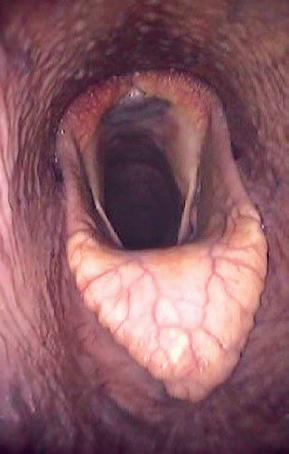
displacement of the soft palate (DDSP), where the soft palate flips over the epiglottis, blocking airflow and causing sudden loss of performance.
Palatal instability often precedes DDSP. Other conditions include medial deviation of the aryepiglottic folds, nasopharyngeal collapse, epiglottic entrapment, and ventral luxation of the arytenoid apex (VLAC). These disorders vary in severity and may be progressive or multifactorial. Barnett clarifies that although surgical interventions target these conditions, outcomes depend on the specific disorder and severity.
Upper airway conditions remain a major cause of poor performance in racehorses, with many requiring multiple surgical interventions. Accurate diagnosis, particularly via exercising endoscopy, is key, as many disorders only become apparent during physical exercise.
Tieback (prosthetic laryngoplasty) is the most common wind surgery but carries risks such as aspiration, pneumonia and swallowing dysfunction, despite efforts to improve surgical techniques. Newer techniques, like standing tiebacks and improved implants (e.g., titanium buttons, reinforced screws), aim to reduce complications and enhance results.
Other surgeries like Hobday (vocal fold removal via laser) were also discussed, emphasizing the delicate nature of airway surgeries and the ongoing challenge to balance treatment effectiveness against risks and complications in our racehorses.
For DDSP, tie-forward surgery, which mimics natural muscle action to restore laryngeal position, has shown positive results, while thermocautery remains controversial. Epiglottic entrapment can now be safely corrected in standing horses using lasers or scissors. Emerging therapies include laryngeal reinnervation and dynamic neuroprosthesis to restore muscle function, as well as vocal fold filling to reduce aspiration pressure.
Collagen cross-linking is also under investigation as a less invasive method for soft palate stiffening. Barnett concludes, precise diagnosis and tailored interventions are crucial for optimal results in treating upper airway disorders in racehorses. These advances reflect a growing push for safer, more effective airway interventions in the racehorse.
Barnett then moved onto discussing the critical role of exercise endoscopy in diagnosing upper airway dysfunction in Thoroughbreds, highlighting the limitations of resting endoscopy. While useful for detecting conditions like total RLN, epiglottic entrapment, or arytenoid chondritis, resting scopes often miss dynamic issues such as soft palate disorders and vocal fold collapse.
Recent developments in overground endoscopy which are battery-powered and rider-compatible, allow evaluation during real time exercise, providing accurate and practical diagnosis. This method has become the preferred standard, especially for assessing palatal instability and early RLN.
Clinical signs such as respiratory noise, poor performance, or sudden stops may indicate airway dysfunction, but accurate diagnosis requires proper exercise testing with horses cantering or galloping while synchronizing breaths per stride. Additional tools like laryngeal ultrasonography aid diagnosis and planning of treatment.
Barnett cautioned against performing airway surgery without thorough diagnostics, as multiple simultaneous conditions can exist, and treatments must be carefully targeted to improve outcomes. Around 25% of Thoroughbreds show clinical RLN, reinforcing the need for tailored, evidence-based treatment plans to support both welfare and performance.
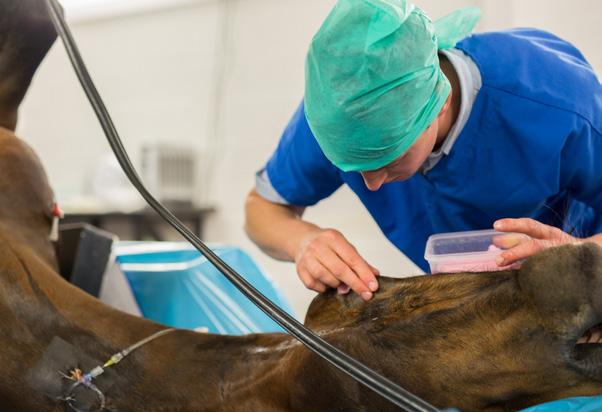

surgeries – the evolution of research and engineering of the tie back and nerve graft
Dr Fabrice Rossignol, of Grosbois/Chantilly Equine Clinic discussed laryngeal surgeries, focussing on the evolution of research and engineering of the tie back and nerve graft. Rossignol’s specialist clinic is at the forefront of treating recurrent laryngeal neuropathy (RLN).
The condition is often linked to degeneration of the recurrent laryngeal nerve, affecting the cricoarytenoideus dorsalis (CAD) muscle, which is critical for opening the airway during exercise. Rossignol explains that this muscle contains few fatigue-resistant fibers, making it vulnerable to atrophy. Even minor narrowing of the airway significantly increases resistance, due to the exponential pressure effects described by Poiseuille’s law.
Diagnosis involves treadmill endoscopy and ultrasonography (caudal view of swallowing can be particularly useful) to assess dynamic airway collapse and muscle atrophy. Treatment is tailored to severity; advanced cases may require a tieback (laryngoplasty) using synthetic prostheses to partially open the arytenoid cartilage, though this risks complications like coughing. Newer techniques aim to restore function rather than replace it. One such innovation combines traditional tieback surgery with nerve grafting from the spinal accessory nerve, which activates during inspiration and contains fatigue-resistant fibers.
This hybrid approach improves airway opening and reduces side effects. Standing surgery under sedation allows more precise suture placement, minimizing anesthetic risk. Emerging technologies like 3D-printed implants and titanium screw anchors further enhance outcomes. Rossignol echoes Barnett’s earlier advice, that early intervention and careful case selection remain key to success.
Dr Rossignol continued on to discuss what and how we, as a racing industry, can learn from other disciplines. Recent research in trotters and sport horses highlights how neck flexion contributes to dorsal and lateral pharyngeal collapse, likely due to nerve inflammation affecting muscles such as the stylopharyngeus. Nasal obstruction, including alar fold collapse and nasal muscle paralysis, also play a role in compromized airflow. Treatment options now include alar fold resection, nasal fenestration (widening), and innovative approaches like titanium mesh implants to replace lost muscular function.
Dr Rossignol explains that high-speed treadmill testing has proven critical in diagnosing dynamic airway conditions, while a multidisciplinary approach involving vets, trainers and farriers enhances management strategies. Use of nasal dilation devices, such as nasal strips, remains restricted under many jurisdictions’ rules of racing.
It is clear that Rossignol champions cross-disciplinary learning, working with trotter trainers over decades has yielded practical insights, such as shoe removal to enhance performance. The methodical, detail-driven tack and equipment adjustments made in trotting disciplines provide valuable lessons in optimizing performance.
Dr Rossignol also shares advances in surgical techniques, including refined approaches to epiglottic entrapment, emphasizing the importance of collaborative care. Cross-disciplinary exchange continues to inform diagnosis, treatment and rehabilitation, enriching equine sports medicine and improving outcomes across disciplines.
To conclude the lectures on wind ops, Mark Johnston, Dr Rossignol and Tim Barnett took to the floor to field audience questions. The discussion focused on recurrent laryngeal hemiplegia (RLN) in horses, highlighting its probable hereditary component but unclear linking between particular genes. Experts note the complexity of breeding influences and caution against oversimplifying genetic causes, as RLN will most likely be linked with other traits.
Surgery helps individual horses but may skew breeding populations, as generally only the more expensive stallions receive treatment. Disclosure of surgeries before breeding is debated but difficult to enforce. Non-surgical solutions like resistance masks
are emerging but their impact on reducing surgery isn’t yet clear. Overall, understanding and managing RLN’s genetics and treatment remain challenging and unresolved.
Early diagnosis of recurrent RLN relies on ultrasonography to detect early muscle atrophy; surgery is recommended promptly to prevent irreversible damage. In contrast, dorsal displacement of the soft palate (DDSP) often stems from muscle fatigue, immaturity, or inflammation and is best treated medically with training and reinforcement until at least three years old. Surgery is a last resort if medical management fails.
Multiple surgeries can be ethical if done safely and explained clearly. Yearling wind testing is variable and challenging to interpret, complicating sales disclosures. The increase in buyers scoping foals’ pre-sale is seen as an invaluable and unpleasant practice due to solid evidence that a foal’s laryngeal physiology will and can change tremendously as they mature. Ongoing research explores novel therapies such as pacemakers and magnetic stimulation.
There is no introduction needed for Mark Johnston, who kindly provided us with his insight on the practical management of tendon rehabilitation. A renowned trainer with decades of experience offered a pragmatic view on tendon injury rehabilitation in racehorses, challenging long-held optimism around recovery. Despite advancements in ultrasound imaging and a range of therapies, from anti-inflammatories to experimental interventions like carbon fiber implants, he is yet to witness a truly successful long-term return to peak performance in top-level racing following a diagnosed tendon injury.
While ultrasound provides valuable detail, he still relies most on visual and tactile assessment, particularly tendon profile and signs of ‘bowing,’ which he considers a critical turning point. In his experience, few flat horses make a full comeback; many may race again, but recurrent issues and shortened careers are the norm. Mark’s approach is rooted in realism: throw everything anti-inflammatory at the injury early, manage workload carefully, and temper expectations.
Long rest alone is rarely effective and controlled rehab and early, aggressive treatment are key. He notes that previous use of prophylactic anti-inflammatories post-race helped reduce injuries, and questions whether restrictions on racecourse treatments may hinder progress. Prevention, early detection, and practical management remain the trainer’s most reliable tools.

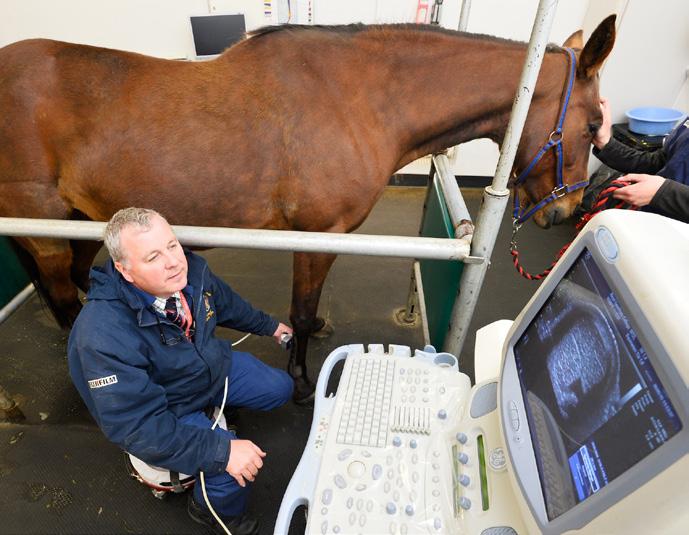
Professor Roger K.W. Smith FRCVS presented a detailed lecture on tendon injuries in racehorses, focusing on the superficial digital flexor tendon (SDFT) and the role of science in improving prevention and rehabilitation strategies. As a key structure for locomotion, the SDFT functions as an energystoring spring but operates near its mechanical limits, especially in Thoroughbreds, making it prone to injury from accumulated loading rather than acute trauma.
Research shows that degeneration often precedes clinical injury, particularly within the interfascicular matrix (IFM), which loses elasticity with age and training. Tendon cells also become less responsive with age, impairing repair. Matrix metalloproteinases (MMPs) are implicated in post-exercise matrix degradation, further weakening the tendon.
Professor Smith emphasized prevention through training adjustments: avoiding hard ground, spacing out intense work, and ensuring sufficient recovery of, ideally 72 hours. Early detection is critical. Diagnostic tools such as ultrasound, Doppler, and Ultrasound Tissue Characterization (UTC) can identify structural changes before injury becomes apparent.
When injury occurs, a prolonged, structured rehabilitation program guided by regular imaging is essential. Biologic therapies like mesenchymal stem cells (MSCs) and plateletrich plasma (PRP) are showing encouraging results, improving tendon structure and reducing re-injury rates. A personalized, biologically informed approach remains key to safeguarding tendon health in racehorses.
Lt. Col. Dr Tom Clack delivered a comprehensive lecture on tendinopathy, highlighting its causes, treatments, and parallels between equine and human medicine. Tendinopathy, a chronic overuse injury, follows a three-stage progression: reactive
tendinopathy (early inflammation), tendon disrepair (structural change and neovascularization), and degenerative tendinopathy (reduced symptoms but increased rupture risk).
Historically, eccentric loading exercises, which came about via human achilles research, became the core treatment. Today, management is more tailored, focusing on biomechanics, load control, and personalized rehabilitation.
Diagnosis includes clinical evaluation and ultrasound, with advanced modalities like shear wave elastography and UTC offering deeper insights into tendon integrity and healing.
Dr Clack advocated a multimodal treatment strategy: progressive loading, extracorporeal shockwave therapy (ESWT), and injectables such as corticosteroids (for short-term relief) and PRP, which supports healing through growth factors.
Crucially, he emphasized the value of Thoroughbred racehorses as models for human tendon injury. Their tendons endure similar high loads, and developments in imaging, PRP, and regenerative therapies in equine medicine are increasingly influencing human sports injury treatment.
Dr Clack echoed the importance of early detection, strategic recovery protocols, and ongoing collaboration between human and veterinary medicine to improve long-term outcomes in equine athletes.
We were then treated to a lecture by Veterinary surgeon Amelia McArthur, who provided a grounded and insightful view on equine rehabilitation, shaped by her hands-on experience running a specialist rehabilitation yard in North Yorkshire. Based at the former training yard of Peter Beaumont, her facility includes a water treadmill, deep sand gallop, extensive hacking, and a quiet stable environment, all tailored to support recovery and performance conditioning.
It is clear that McArthur advocates for a genuinely holistic approach, not rooted in fads, but in understanding the whole horse: injury history, temperament, conformation, previous management, and future athletic goals. Rehabilitation begins with controlled exercise, which is often hand-walking, though she acknowledges the safety challenges of managing fresh horses, advising use of protective gear and sedation when necessary. In-stable physiotherapy, such as weight-shifts and limb lifts, can supplement or replace walking early on.
She stresses that rehabilitation literature often lacks clarity, so individualized programs with regular reassessment, particularly ultrasound checks, are essential. Progressive loading, surface variation, and adapting treadmill use depending on injury type all help prevent reinjury. For tendon cases, treadmill work is delayed to avoid strain from reduced slip.
Crucially, McArthur highlighted the impact of rider weight and balance, particularly for ex-racehorses, and the importance of body condition in supporting soundness. A striking case study showed how fat loss transformed a Highland pony’s tendon recovery and competitive ability.

The final open floor discussion of the day took place between Mark Johnston, Professor Roger Smith, Dr Tom Clack and Amelia McArthur.
The topic of military-style training programs running parallel with equine management were discussed, particularly in managing overuse injuries like stress fractures. Key strategies include load management and gradual conditioning over 4–8 week cycles. It was noted that today’s horses, like modern human recruits, can often lack natural conditioning, especially in the feet, increasing injury risk.













Prevention is focused on structured training that supports both tendon and bone development, particularly in young horses (yearlings), where tendons must adapt before bones are heavily loaded. Ground conditions and surface variation also play a complex role in musculoskeletal health.
Rehabilitation and pre-training approaches remain debated, but there’s agreement that progressive, controlled exercise is essential. Tendon injuries, especially in flat racehorses, are notoriously hard to overcome. Advances in ultrasound and imaging, such as UTC and shockwave elastography offer new promise, though they come with high costs and technical demands.
Steeplechase horses often return to competition successfully after injury, offering hope, but managing owner expectations remains key. Medication use, such as dexamethasone, is tightly regulated on racecourses to uphold integrity. Like elite human athletes, horses need carefully balanced workloads and rest to prevent chronic damage. While rehabilitation methods are improving, prevention remains the best strategy.
This year’s renewal of the Gerald Leigh Memorial Lectures was once again full to the brim with exciting new research and innovative thoughts from world leading experts. Attendees, all involved within various areas of the horseracing industry made for diverse and thought-provoking discussions.
The commonality amongst the lecturers and attendees alike was the undeniable commitment to ensuring the betterment of equine welfare in all avenues of bloodstock, racing and life after. Safe to say, all who attended are already looking forward to the 2026 lectures.



























































































Who doesn’t want to produce a performance athlete who is less stressed, experiences fewer setbacks and enjoys improved welfare? It has been shown that correct application of learning theory principles, starting from a young age, can clear the track.
Learning theory explains how each horse acquires, processes, and remembers the knowledge they need to perform as a racehorse. For handlers this means developing a deep understanding of how a horse learns. Naturally gifted horsepersons are already employing some of the principles, often without even knowing it, with their impeccable timing of cues.
In the past two decades, both social license to operate and equine welfare have come to the forefront. Failing to grasp how the horse’s brain works (both their capabilities and limitations) can lead to confusion, unnecessary stress, and dangerous behaviors. Conversely, understanding equine learning theory can streamline training, lessen the chances of injury to both horse and handler and improve efficiency in training.
Globally recognized for their success training Thoroughbred foals, Foal NZ has been achieving remarkable results in New Zealand. Through utilizing learning theory they have completed over 35,000 training sessions without injury for the past two decades. Yearlings fetching million-dollar price tags and Group One race champions such as So You Think, Military Move and Jimmy Choux emerged from the program, earning acclaim in Thoroughbred racing circles.
Learning theory is a way of explaining the different types of training typically used with horses and contains four main quadrants that explain how consequence is used to shape behavior. Sally King of Foal NZ explains how they use learning theory to create confident, capable young athletes.
Aim:Tomakeadesirable behavior more likelyinthefuture


The Foal NZ team use primarily positive and negative reinforcement to encourage the foals to learn the desired behavior while becoming confident in both their ability to learn and their relationships with people. Using negative reinforcement (removing a cue the horse doesn’t enjoy as soon as the horse responds), the handler will ask the foal to move forward using pressure from a rope around the foal’s rump, releasing the pressure as the foal moves the first foot off the ground.
Once the foal is confident about being touched by people, then they will start to include positive reinforcement (doing something the horse likes) by offering the foal neck scratches once a desired behavior is performed. “This encourages the foal to try to find the solution to what we are asking as they feel relaxed and confident in their abilities – the perfect mental state for accelerated learning,” says King.
Positive punishment (adding something the horse does not like such as vocal or physical reprimand) is less effective than other methods. An example of positive punishment is when a horse rears and ‘shanking’ the horse’s face is employed to punish them. While this may work temporarily as the horse attempts to avoid pain, numerous studies in children have shown that using positive punishment creates anxiety and fear and reduces brain function. Likewise, if the horse is afraid, they are hindered from using their brain to find solutions. Handlers that can recognize stress from facial expressions, muscle tension, and behaviors can pre-empt the rear by changing the situation to reduce tension.
Negative punishment (taking something away that the horse enjoys or values) is generally not recommended as this may cause stress and increase anxiety.
Desensitizing and flooding are two learning concepts that have also been used in training. Desensitizing involves gradually getting the horse accustomed to something, while flooding entails exposing the horse to a frightening stimulus in an intense and unavoidable manner. For instance, a young horse may spook or hesitate at a particular part of the track during their morning workout due to something new or unusual appearing in that area.

If a colt spooks and stops, and the handler was to tie them or hold them so they were forced to stay near what was frightening them, this would be called flooding. Eventually the horse would stop showing the fear behaviors but only because they have learned that nothing they do will make the scary object go away. It is not because the horse now feels comfortable in that area. Flooding can have a compounding effect called ‘trigger stacking’. Initially, the horse may suppress signs of fear, but as stress accumulates and the threshold is crossed, it can lead to sudden, intense reactions or behavioral outbursts.
In contrast, desensitization could involve putting more distance between the horse and the ‘scary’ area at first. They may pass that area alongside another horse to gradually increase comfort with that part of the track, enabling pace to be maintained in future laps. A jockey that can sense his mount starting to hesitate or veer away can use their powers of prediction to desensitize and foster confidence rather than risk escalating stress.
Another well-applied example of learning theory is how trainers typically ‘shape’ responses when introducing horses to the starting gates. Trainers typically break down the elements of being able to use starting gates successfully into multiple parts, gradually going from walking past the gates to walking through open gates following a lead horse, to being beside the lead horse, to stopping inside the open gates, to stopping with one gate closed, then two, then waiting inside, then breaking at a walk and subsequently faster gaits. This way of training called ‘shaping’ also considers the horses ethology in understanding that they are social, prey animals and can feel uncomfortable being restricted in small spaces.
Timing and consistency are arguably the most important tenets of effective training; if the horse can predict what the handler or rider wants and knows they will consistently ask for the behavior in the same way each time, they are much more likely to perform successfully and confidently.
Effective training relies on the simple relationship between the cue, the response and the reinforcement and being able to read stress levels. “In the bloodstock industry, young horses are more likely to be exposed to a wider range of handlers and environments than sport horses but will typically have to perform a smaller range of behaviors than a sport horse,” says King. Thorough training of cues and responses will set the horse up for future success when a wide range of handlers, with varying experience ask the horses to perform behaviors during varying states of arousal.
Using a training system that uses clear principles of learning and lessens the occurrence of conflict behavior, avoidance and escape behaviors has positive outcomes for both horse and human safety and welfare. A young horse that has been trained this way will be more compliant, better able to cope with environmental and social changes and consequently safer. Not only that, but they will feel like they can predict their world, succeed at their job and have some sense of control over what happens to them – all things that increase self-confidence and thus optimize performance.
Within a busy yard, there are time pressures often resulting in limited time to achieve results. Using clear and consistent approaches based on learning theory results in quicker and more robust training, more efficient use of staff time and therefore increased productivity; and for most organizations, improved commercial viability.
This brings us to the next question – How well can you tell? Can a wide range of horse handlers accurately gauge a horse’s behavior as positive, neutral or negative? Dr. Katrina Merkies, a professor in the Department of Animal Biosciences at the Ontario Agricultural College has collaborated on numerous horse behavior studies and recently published a paper on this very topic.
As it turns out, most of us might not be as perceptive as we think. Merkies’ recent study explored how accurately people can interpret horse-human interactions by looking at photos and watching videos. On average, participants correctly identified whether a situation was positive, negative or neutral only about 52% of the time, which is barely better than chance.


One of the central questions of the study was whether people who are more in tune with their own bodily sensations—such as heartbeat, breathing, or muscle tension—are also better at interpreting the emotional states of horses. This idea stems from human psychology research, which shows that individuals with greater internal awareness, or interoception, tend to be more empathetic toward others.
To explore this in the context of human-horse interactions, the researchers used a tool called the Multidimensional Assessment of Interoceptive Awareness (MAIA-2). This reliable questionnaire measures how aware people are of their internal bodily states across eight dimensions, including emotional awareness, attention regulation, and body listening. Participants rated themselves on a scale from 0 (not at all) to 5 (very much) for each item.
Participants were asked to evaluate the various horse-human interaction clips before the MAIA-2 results were recorded to avoid skewing the results. Surprisingly, the results showed no significant correlation between a person’s interoceptive awareness and their ability to accurately assess the horse’s emotional state.
This unexpected outcome raises several possibilities. It could mean that interoceptive awareness simply doesn’t translate across species, or that the MAIA-2 isn’t the right tool for this kind of cross-species empathy. Another possibility is that the participants—many of whom were highly experienced with horses—relied more on their practical knowledge than on emotional intuition when evaluating the clips.
To establish a benchmark, the researchers first had equine behavior specialists evaluate the same media. Their assessments were treated as the gold standard. When the study participants viewed these clips, their interpretations often missed the mark— unless the emotional cues were especially obvious. For instance, people were more likely to recognize a negative scenario when a horse clearly refused to walk across a tarp, or a positive one when a foal willingly approached a person for attention.
These results raise important questions about how well we understand the emotional lives of animals, and how that understanding—or lack thereof—can impact their welfare and how we approach training.
While people were somewhat successful at identifying obvious emotional cues in horses, the study revealed a significant gap in recognizing more subtle indicators. According to Dr. Merkies, many of these nuanced signals are found in the horse’s facial expressions. Participants often reported focusing on the horse’s face to gauge their emotional state but frequently overlooked finer details.
Some of the key subtle cues included the direction of the horse’s ears, tension lines around the eyes, and the flaring of nostrils. These small but telling signs can reveal a lot about how a horse is feeling—whether they are anxious, curious, or relaxed. Unfortunately, these indicators are not always easy to spot, especially for those without specialized training in equine behavior.
Improving our ability to recognize these subtle cues could raise the bar for increasing positive human-animal interactions and improving the chances of early intervention at the first sign of physical issues.
The study highlights a clear need for improvement in how people perceive and interpret subtle equine behaviors. So how can we get better at this? According to Dr. Merkies, education is the obvious starting point—but it’s not the whole solution. “We can learn about these cues,” Merkies explains, “but being able to apply that knowledge in real-life situations is a different challenge.”
One promising approach is the use of tools like the Horse Grimace Scale which can help observers assess facial expressions and other subtle signs of discomfort. These tools are gaining traction in professional settings; for example, the Hamilton Mounted Police unit uses facial grimace scoring as part of their daily horse care routine. Incorporating such practices into everyday horse management can train people to notice and interpret the finer details of equine behavior.
Scan the QR code for the Horse Grimace Scale
Dr. Merkies emphasizes the importance of shifting our perspective: “We need to stop, listen, and pay attention—not from an anthropomorphic viewpoint, but by trying to understand how the horse is experiencing the situation.” This means resisting the urge to project human emotions onto horses and instead learning to see the world through their eyes.
Another barrier to better understanding horses is the normalization of certain behaviors within the equine industry. “There are a lot of myths that get passed down and accepted as just the way things are,” says Dr. Merkies. Take, for example, a horse pinning their ears when the girth is tightened. This is often dismissed as the horse being a grouch or even ‘normal’ behavior for that horse, but this mindset can prevent us from asking deeper questions: Why is the horse reacting this way?

What are they trying to communicate? Is there a physical reason for this reaction?
Another great example of negative feedback, often ignored or normalized, is a horse that displays discomfort while being groomed by constant fidgeting, head tossing or grimacing. Again, the discomfort should be acknowledged and addressed, perhaps with softer brushes or counter-condition using positive reinforcement. Is there a physical issue that requires veterinary intervention?
By challenging long-held assumptions and encouraging critical thinking, the equine community can move toward more benevolent and informed interactions with horses.
One of the most promising ways to improve horse training and welfare is through the use of positive reinforcement—a method that rewards desired behaviors to encourage their repetition. Dr. Merkies emphasizes that this approach not only works but often leads to better outcomes than traditional methods that rely on punishment or pressure.
Despite its effectiveness, positive reinforcement is sometimes misunderstood. Common myths suggest it might make horses ‘mouthy’ or lead to weight gain from treat overuse. Others argue it’s unnecessary because a horse should obey out of affection or loyalty. These misconceptions can discourage people from adopting more compassionate and effective training techniques.
Positive reinforcement doesn’t have to be complicated—or even food-based. While treats are a common and convenient reward, other reinforcers can include scratches, companionship, or access to a favorite location. The key is understanding what motivates your individual horse.
Dr. Merkies offers a simple but powerful example: “When you go to halter your horse, do they come to you, ignore you,

or turn away?” These responses are forms of feedback. Even subtle behaviors—like a horse turning its head slightly away when approached—can signal discomfort or reluctance.
Recognizing and responding to these cues can transform training into a more cooperative and enjoyable experience for both horse and handler.
Ultimately, positive reinforcement fosters a relationship built on trust and mutual respect. “It’s super satisfying,” says Dr. Merkies, “when they come running up to the gate or whinny from the field. Then I know they’re looking forward to the training session.”
The benefits of a horse experiencing more positive interactions with humans than negative ones are obvious from a welfare and safety standpoint. When a horse is repeatedly exposed to negative interactions with humans, they may develop fear or resistance, which can make handling more challenging and increase the risk of injury for both the horse and the handler. If you are looking for ways to use more carrot and less stick to reduce stress and setbacks, consider applying the principles of learning theory to your horse training program.
References:
• Sally King, Leigh Wills, Hayley Randle, Early training of foals using the ISES training principles, Journal of Veterinary Behavior, Volume 29, 2019, Pages 140-146, ISSN 1558-7878,
• Merkies K and Trudel K (2024). How well can you tell? Success of human categorisation of horse behavioural responses depicted in media. Animal Welfare, 33, e50, 1–11
• The Horse Grimace Pain Scale: Dalla Costa, Emanuela & Minero, Michela & Lebelt, Dirk & Stucke, Diana & Canali, Elisabetta & Leach, Matthew. (2014). Development of the Horse Grimace Scale (HGS) as a Pain Assessment Tool in Horses Undergoing Routine Castration. PloS one. 9. e92281. 10.1371/journal.pone.0092281.
• Operant conditioning chart reprinted with kind permission of World Horse Welfare. www.worldhorsewelfare.org/advice/training-how-do-horses-learn
Equine Guelph offers both short courses and an in-depth 12-week online program in horse behaviour. Scan the QR code for more details
The West Virginia Thoroughbred Breeders Association announces increased opportunities for Breeders in 2025!
10% INCREASE IN PURSES EFFECTIVE JULY 17, 2025 10% INCREASE IN BREEDERS AWARDS TO $4.5M
WV Thoroughbred Breeders’ Program continues to provide some of the best benefits in the nation to owners/breeders of WV-accredited and WV-sired horses
• $800,000 annually for Stakes Races Restricted to WV Breds
• 160 days of racing at Charles Town Race Track with at least up to THREE-races Restricted to WV Breds and over 125 days of racing at Mountaineer Race Track with at least TWO-races Restricted to WV Breds
• WV Breds can go through their conditions twice! Once in WV Restricted Races and then again in Open Company at WV Race tracks
• Annual October WV Breeders Classics with $1M in purses
• $1M in Supplemental Awards
• AND WV Breeders awards are earned from first place to last place



We have certain people we work with, a team of about five of us. We’ve been going to Keeneland for 30 years or more and we’ve had some success there with the budget we have to spend. We’re pretty pleased with what we’ve accomplished over the years, so the opinion of others really doesn’t come into play.




The opinions of others cloud my decisions sometimes. I like to go in it myself, my initial reaction when I look at the horse myself. I base it on what I see in the horse. I try to keep the outside noise out. I’ve made some mistakes by listening to other people sometimes. At the end of the day, I go with what people call is a gut feeling. I call it experience of what worked for me and what didn’t work for me.

I think you’ve got to have your opinion on them. I have people I work with, obviously, or if you’re looking for a client, you have to take their opinions on board, too. I mean they do influence you depending on the circumstances, but at the end of the day you have to have your own opinion.
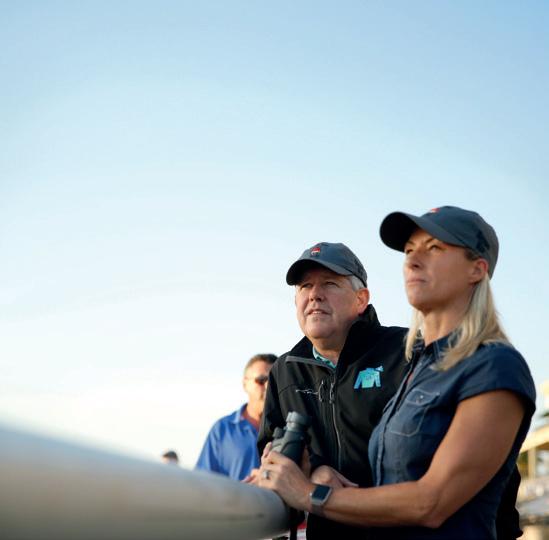
If I don’t like the yearling, I don’t buy it. But there’s been times where I like the yearling and someone might point something out to me that makes me take a closer look and veer away from it. We’re always capable of having a second set of eyes or a third set of eyes. I rarely look at a horse by myself. We usually have a team, an agent, my wife and I. In some cases an owner wants to look at them, too. We do miss things.


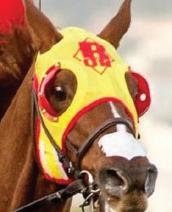









When I’m making yearling selections, truthfully, everybody looks for different things. For me, personally, I like to tune out background noise and try to make my own decisions. Because, at the end of the day, I want to be happy with what I’ve selected and not so much based on what other people have to say.




Everybody’s got an opinion on a yearling. One guy will look at a horse and like him. The next guy – he just doesn’t like him. I do a physical. If the vet doesn’t like him, it’s very rare I’ll go against the vet. If he says it’s a 10 percent risk, that’s something different. Then I’ll let the price determine it. But if he’s telling me, “Stay away,” I’m staying away.
Everything is useful information. That’s the way I look at it. If you get to the point where you’re considering buying a yearling and a vet is telling you it’s got a problem, you’d want to steer away from it. As far as anything else, you can look it up. I have a high regard for the people that handle the hose, that are around the horse. So they know if it’s a nervous horse or a horse that’s a little more mentally mature. To be honest with you, I value everybody’s opinion, and then you just have to draw your own conclusion.

A lot of people have teams, including myself. If it’s a team member, I’m all ears. Otherwise, I don’t really pay too much attention. We’ve been doing it a long time. We end up agreeing most of the time, and if we don’t agree we just throw it out and move on to the next. It’s us three, me and Frank and Daphne Wooten from Camden, South Carolina. They break our yearlings. We’ve been doing it together for quite a while. We’ve gotten lucky. Lucky is a very important word with yearlings.
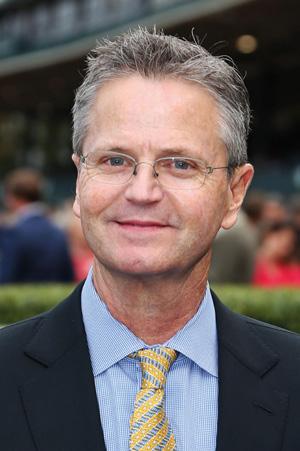
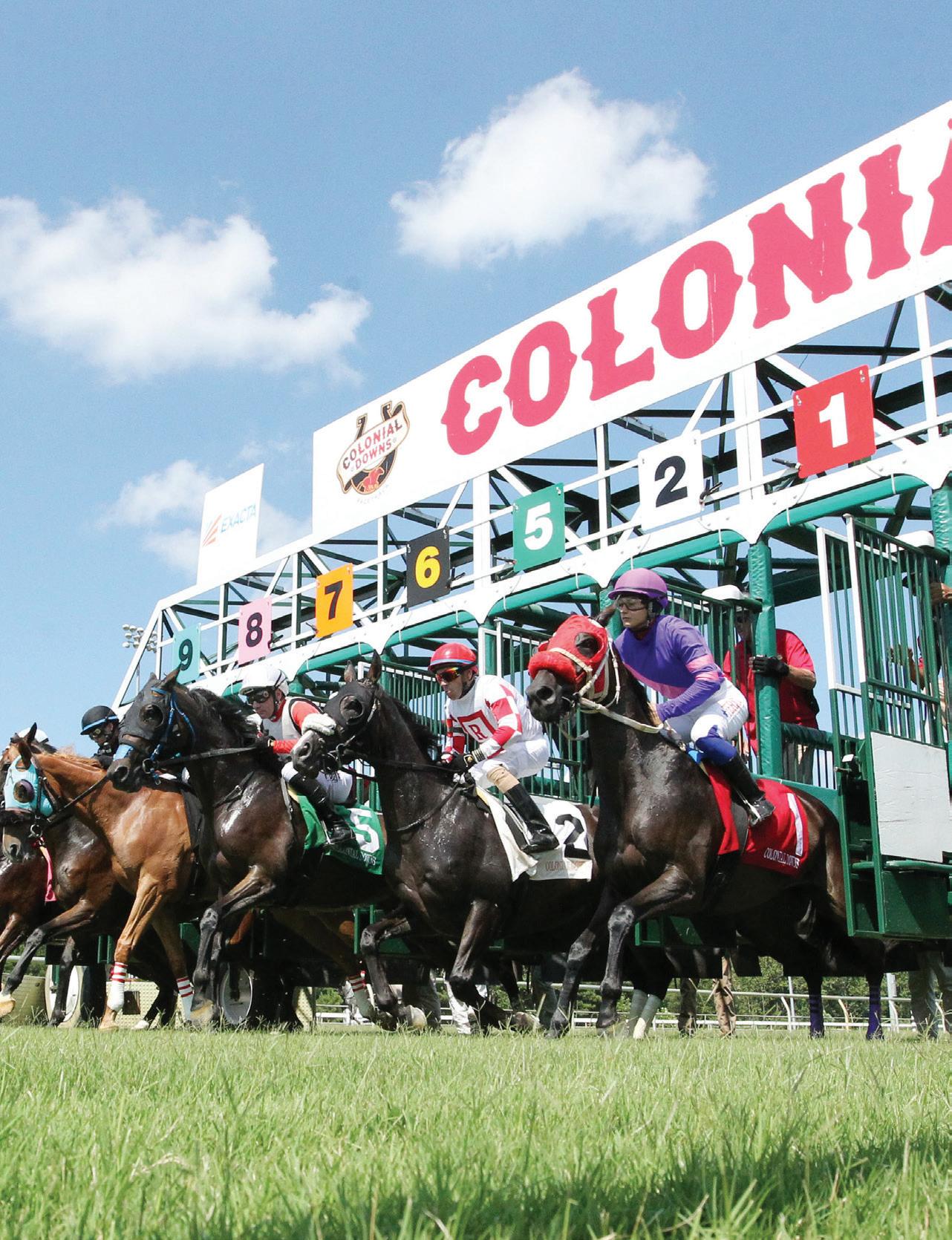
41 days: July 9 – Sept 13

SIX STAKES for VA-bred/sired and MD-bred/sired
Eligibility: must be registered with state-bred association
FOUR STAKES for VA-bred/sired
Eligibility: must be registered with VTA
VA-RESTRICTED RACES including overnight handicaps and stakes
Eligibility: must be registered VA-bred/sired or VA-certified
• VA restricted purses at Colonial Downs are 25% higher than the open races
• Earn a 50% bonus on earned purses for 1st-4th in open races at Colonial Downs
• Bonuses for VA-Breds for 1st-3rd finishes in open races in North America (excludes state-bred, state-sired races)
• Bonuses for all 1st-3rd finishes at Colonial Downs meets and NSA meets
Defined as the owner of horse in first lifetime start
Up to a 25% bonus for any open race win in the Mid-Atlantic & NY, including NSA sanctioned meets
• VA restricted purses at Colonial Downs are 25% higher than the open races
* Defined as the owner of horse in first lifetime start
Up to a 25% bonus for any open race win in the Mid-Atlantic & NY, including NSA sanctioned meets
• 10% bonus for state-bred restricted wins in the Mid-Atlantic & NY, including NSA sanctioned meets

Trainers receive a $300 bonus per starter at Colonial Downs
BONUSES WILL NOT BE EARNED FOR OUT-OF-STATE WINS DURING THE COLONIAL DOWNS MEET
For complete details on the VA-Bred and VA-certified programs, go to VaBred.org Or contact the Virginia Thoroughbred Association at 434-977-3716
